In the world of P2P, Bittorrent is clearly the protocol of choice for big file transfers. This is true for videos (pirated or not), for GNU/Linux dsitribution CD-ROMs, for collections of photographic images, etc.
Among the Bittorrent-compatible P2P software applications, Azureus is clearly the one that receives the favors of the greatest public. It is proved by the participation to the networks. It quite certainly comes from the Azureus versatility, but also from its flexibility allowing it to be present on many different computing platforms (written in Java, it was ported to almost anything including a microprocessor: Apple, Linux, Windows PC, Unix workstations, etc.). But it comes with one hidden cost: Configuration nightmares, hundreds of options, some of them nearly impossible to understand at first. Azureus makes it a bit easier by breaking the configuration in several expertise levels, but it still is very complex.
When I wanted to install Azureus, even with my own computer experience, sometimes I was a little lost when lokoing for the best options to configure my machine. So, I decided to share this recently hard-earned expertise, with some of my own comments.
The PC running Azureus
First, I’d like to describe the PC configuration I used to run this copy of Azureus:
- Windows 2000 Pro
- Athlon 2600+
- 1 GB of DRAM
- Plenty of free hard disk space
Configuration
First remark: In order to be able to display it all, I need to present 1280×1024 screen copies. It tells all about the lenght of the list of options. If you want to see them in a more readable way, just click on the screen copies to pop them up in full glory résolution.
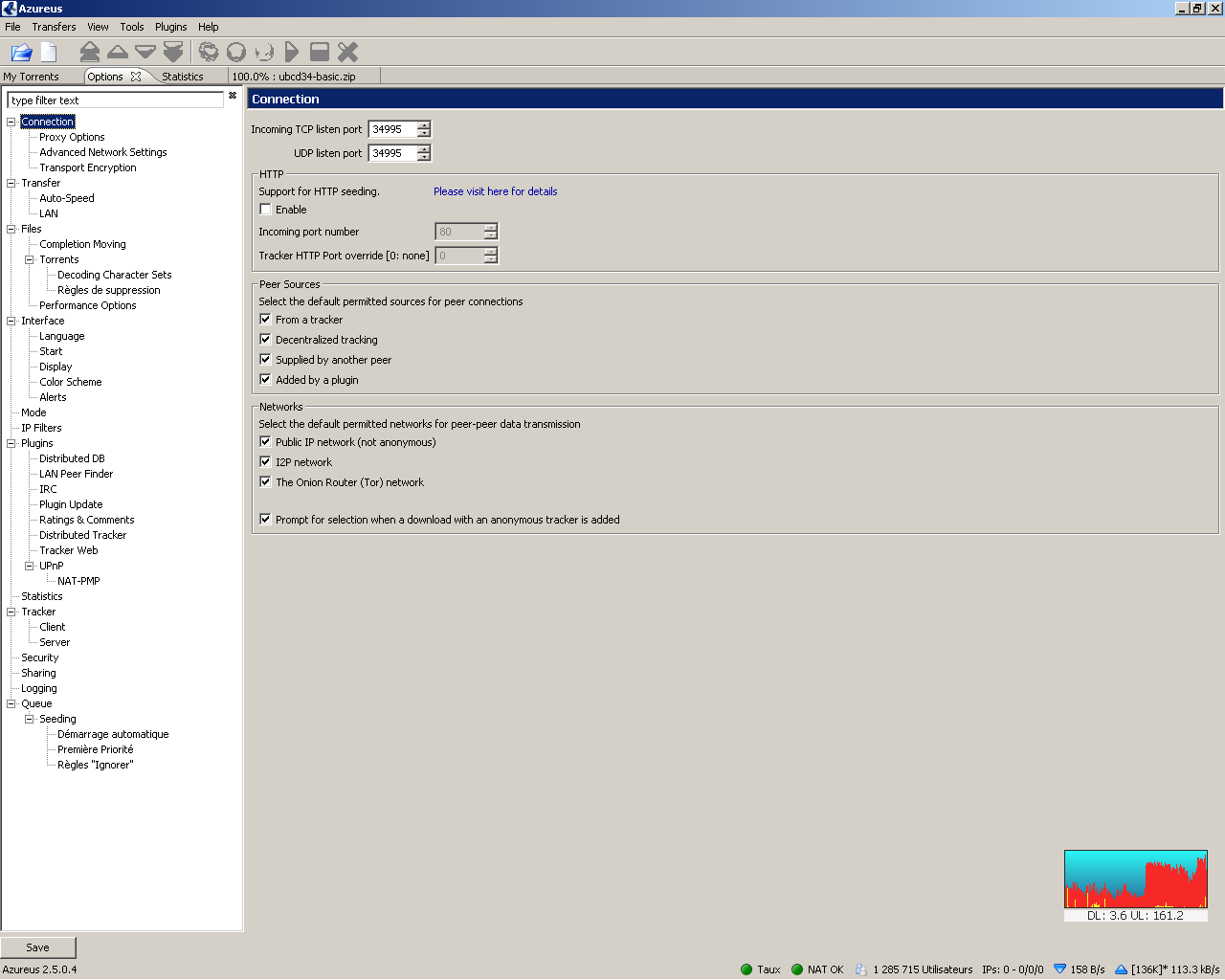
TCP and UDP have been choosen randomly by Azureus at installation time. Just remember to open your firewall for these ports, or the speed will be VERY slow (10 to 100 times slower than you could expect).
HTTP is there only if your intent is to distribute your own files. I advise you not to use it.
All origins and all networks are selected. The ability to use only networks like I2P and Onion Router/TOR is present only for the participation to tightly-secured networks from next generation (I2P is nearly never found out of the American universities) or for the stealthing of your activities (TOR was developped specifically to work anonymously on the Internet – either in a country were civil liberties are restricted and censorship is actively enforced on the Internet like China, Iran or Tunisia, or to participate to illegal activities). But this is quite marginal and you will probably not need them if you are not already acquainted with them.
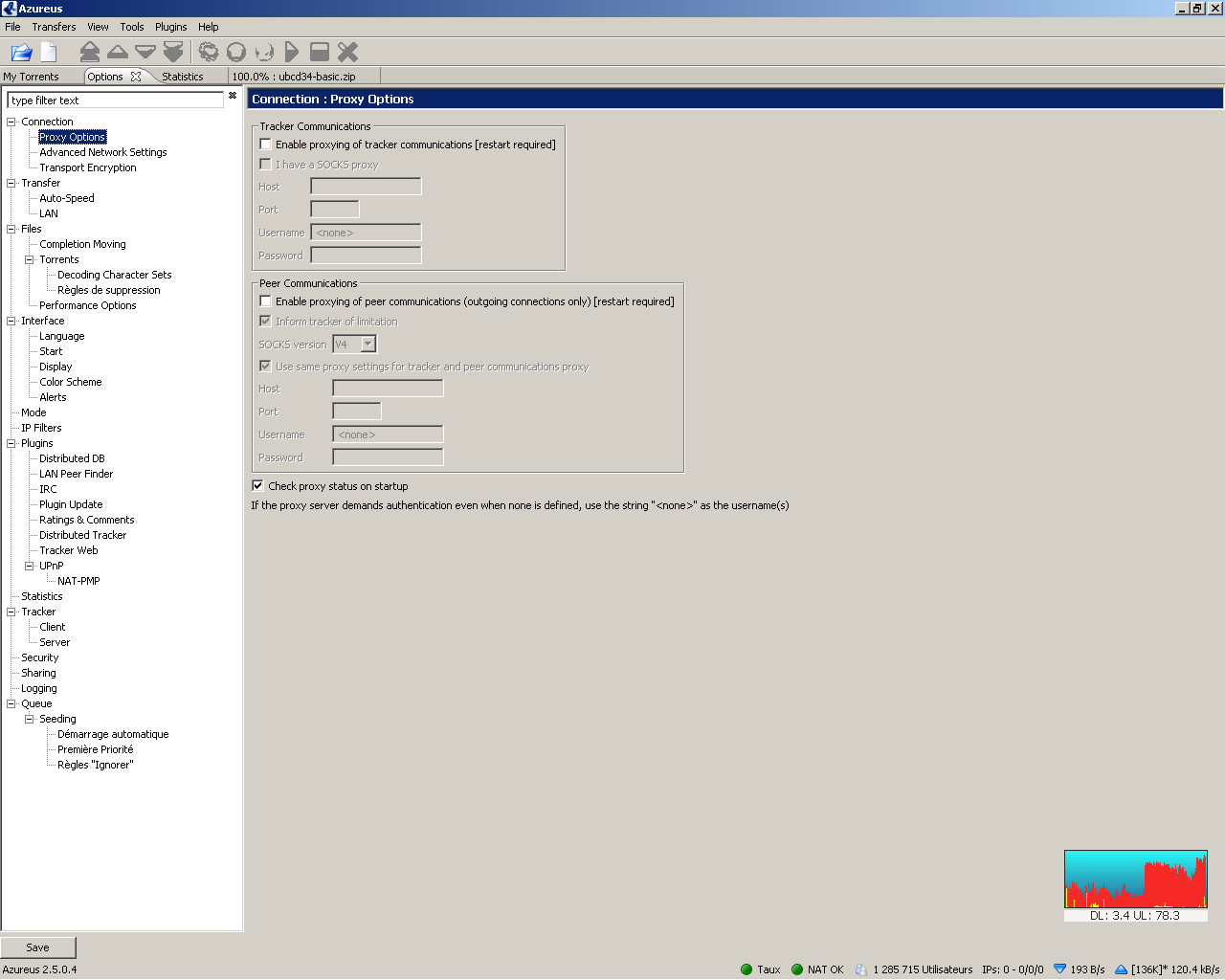
Since I don’t use and Internet proxy, I did not care trying to configure one. If you need to go through a Proxy, it will probably be a little difficult to reach the higher download rates of Azureus (you have to share the proxy ressources with other people/machines…)
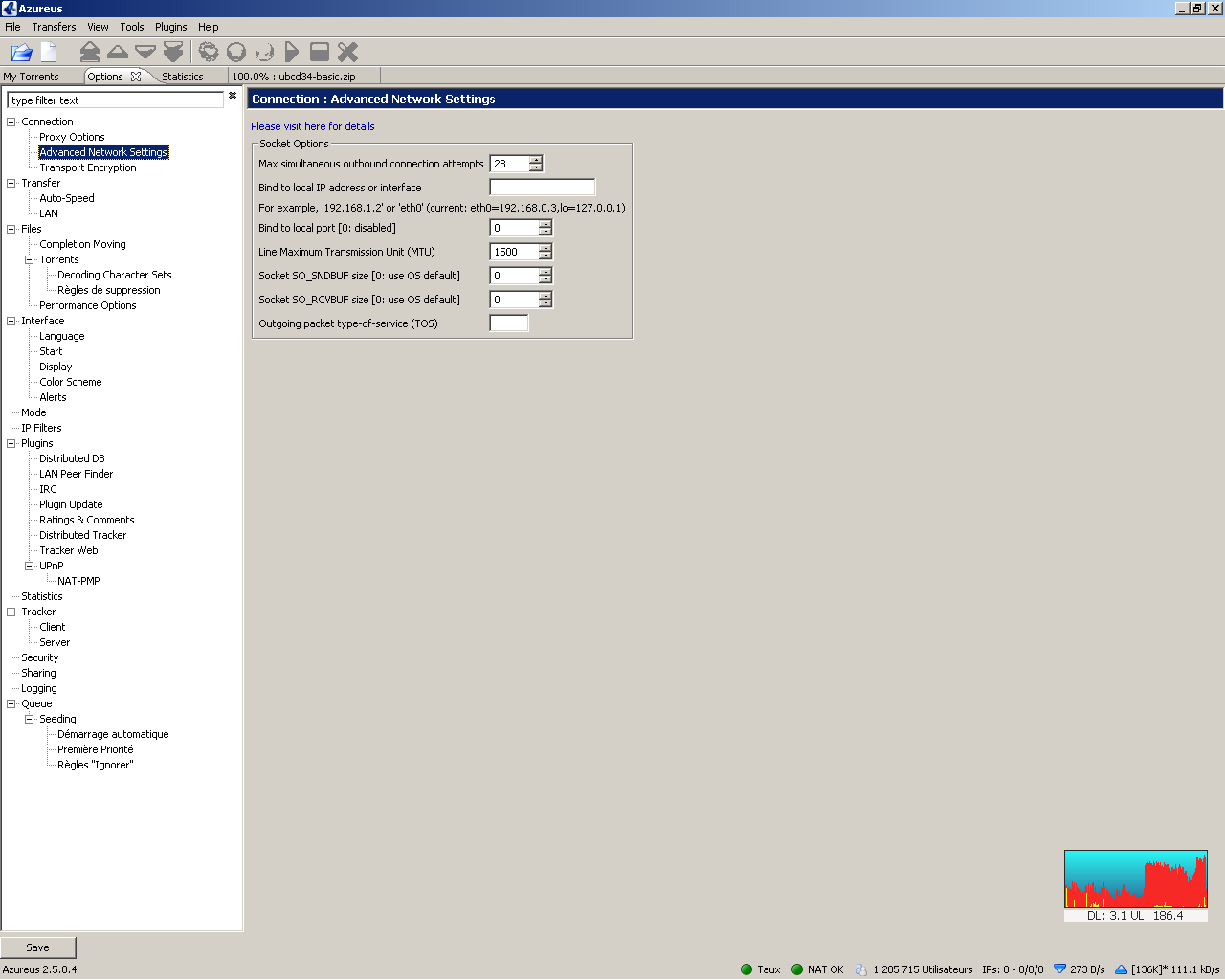
Easy choice here. The number of simultaneous outgoing connections must not be too high to avoid saturation of the computer capacity: Windows 98 was quite limited here, but Windows 200, XP or Vista no longer have this kind of difficulty.Unix, GNU/Linux and Apple do not have this problem for a long time.
The local address of my PC being in the C category (192.168.0.x) I did not need to meddle with the next ones. The MTU value may be optimised for some machines, but the usual value of 1500 is the one most commonly found in the broadband networks.
If you have a router or ISP that supports the advanced management of Quality of Service, you may set a TOS value according to your documentation. It may favor slightly some service (you will probably be willing to ensure good audio quality on VoIP phone or video quality on TV over IP).
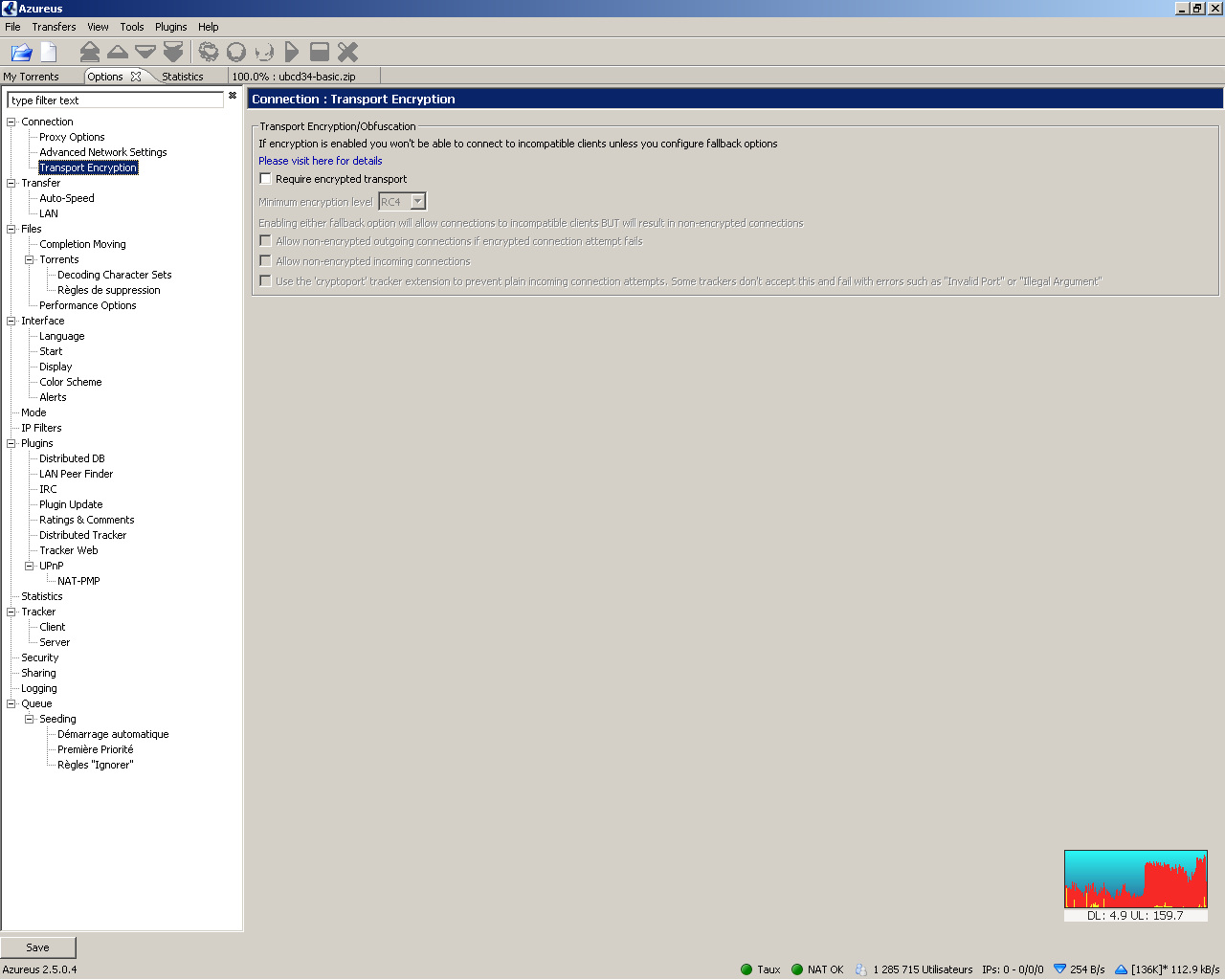
If you don’t need it explicitly (if your ISP is not filtering the Bittorrent protocol out), I advise you not to encrpyt any of those communications. Or you’ll limit a lot the number of accessible P2P peers you will be able to reach.
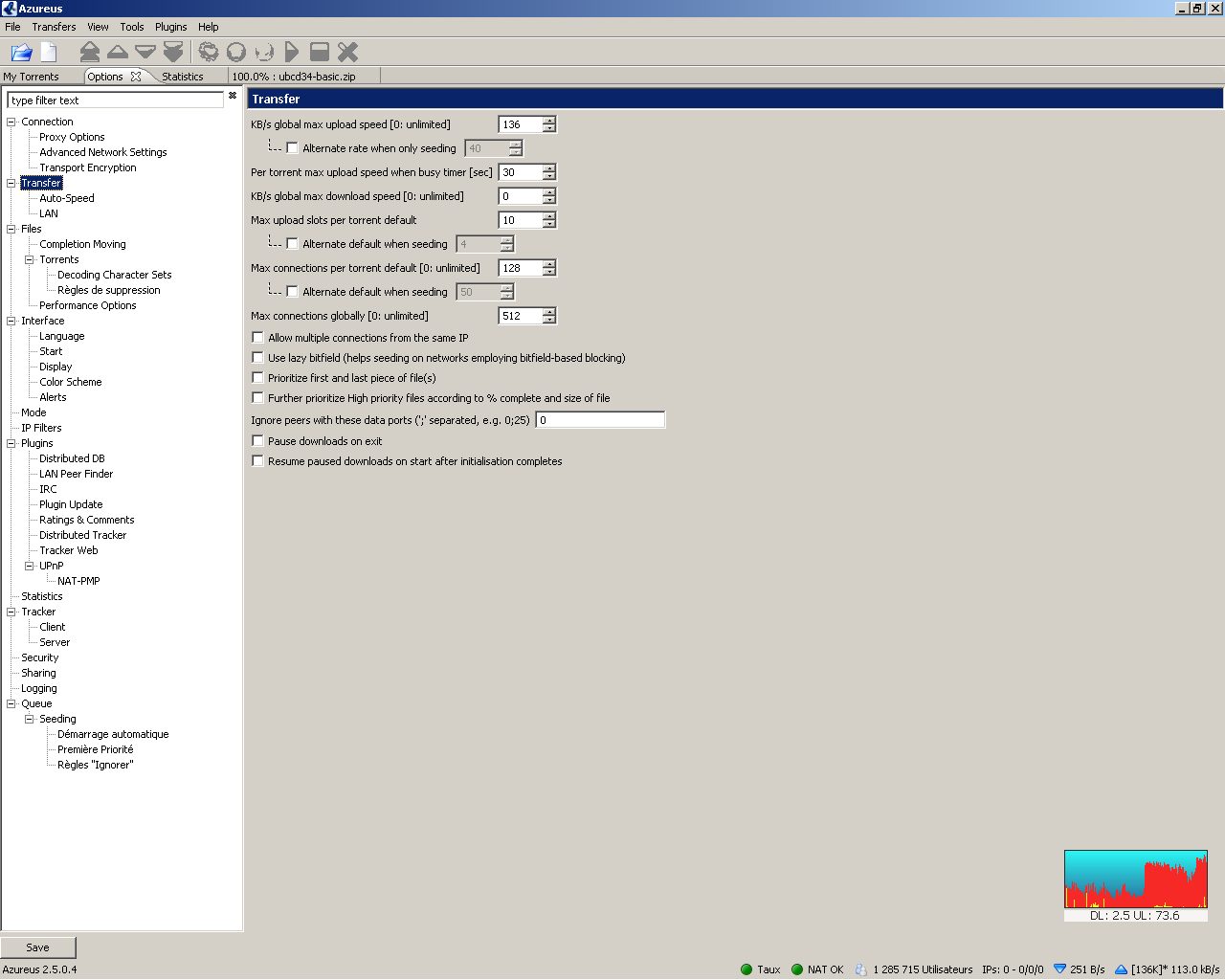
Here, attention is needed. The values shown here are more or less optimal for a broadband 20/22 Mbit/s ADSL connection like is found in many European countries (including the standard Free ADSL in France, like mine). But the global maximal upload speed was first set to 0 (unlimited) before setting up the automatic choice (see below). So, the value displayed here (136) is actually a transitional value varying from one minute to the next according to the automatic decisions of Azureus. Just set 0.
The values maximum connections were set by me to slightly limit the work load forced onto my PC. After all, an AMD Athlon 2600+ is not really a power monster and I use it for many other things than Bittorrent P2P…
Last but not least, I denied any kind of priority to special parts of files. This is hardly useful and tends to slightly reduce the overall download performance of a specific file ; but your choice may be as good as mine.
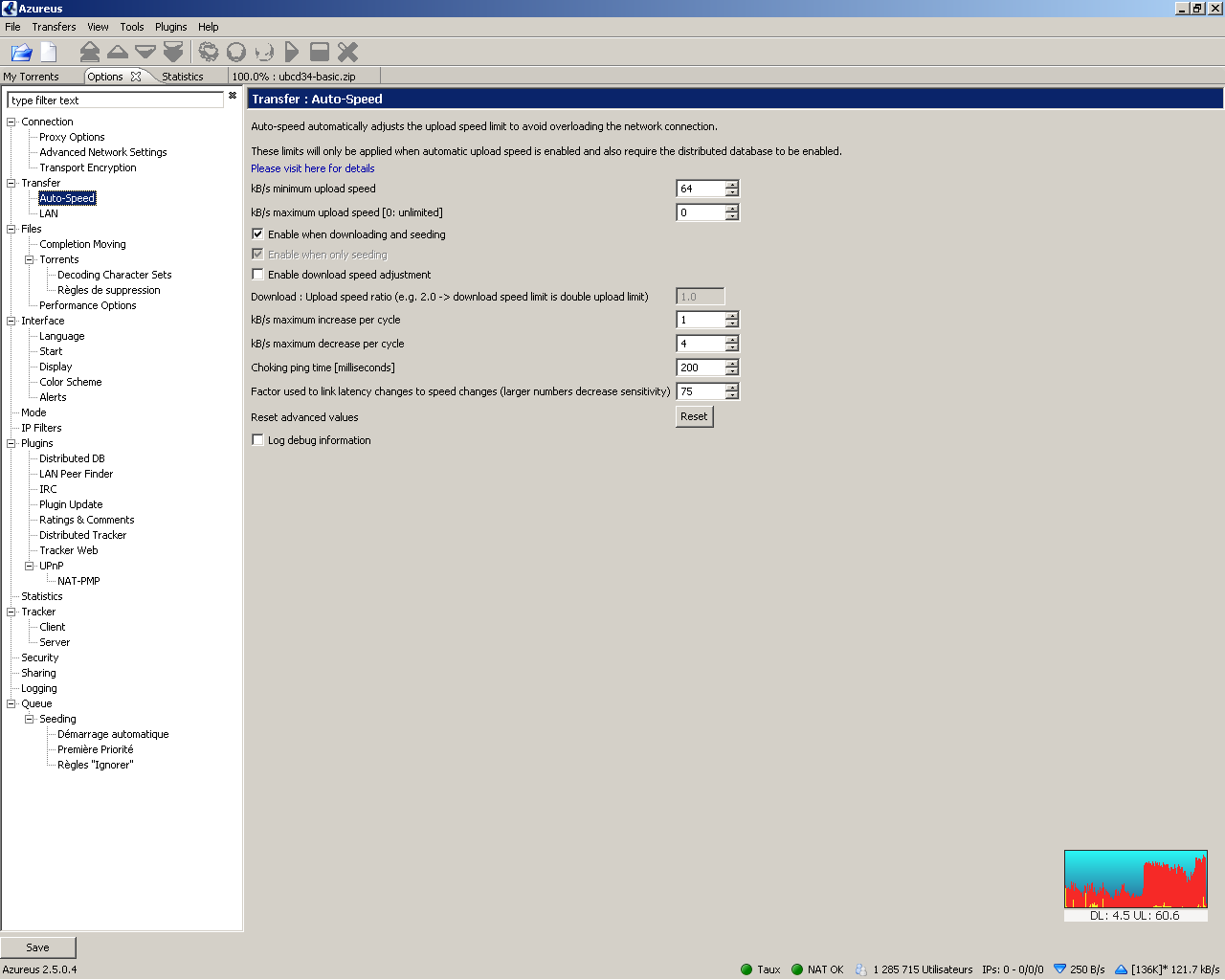
This is a follow-up on the previous configuration page. And it is important. I configured it for automatically adaptable performance (Azureus is astonishingly good at that). I only gave a minimum upload value to avoid seeing the upload drop to null too easily: 64 kB/s. Here, your choice of values is nearly as good as mine. I more or less chose to set it to half of the maximum capacity of the upload link here (about 120 kB/s in upload). But you could as well choose a somewhat smaller value (32 kB/s); Don’t expect any dramatic impact here.
On the contrary, I don’t want to see Azureus playing with any kind of maximum limit for the download side. As a matter of fact, a modern ADSL broadband is nearly impossible to cap and if this happens the download is so fast that it will be finished in no time.
The other parameters are set to have a good reaction when decreasing is needed (Azureus decision is often a good one) and to be more conservative when time comes to climb back up again (simply for my own confort and security).
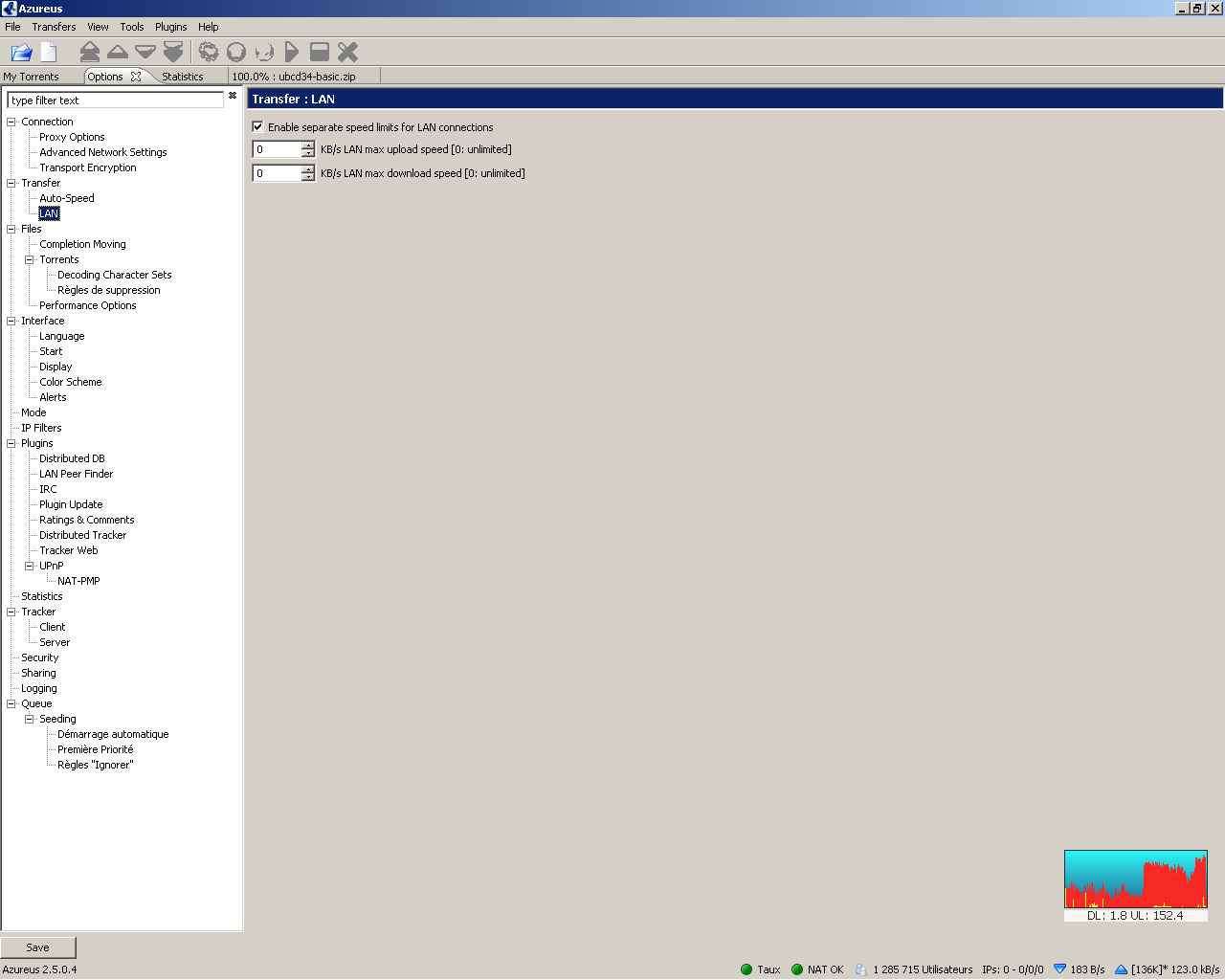
LAN connection speed limits only have a meaning if you can find other peers on the local network. This is not my case at all (despite the number of boxes connected to my LAN) and this is generally not the case (maybe except in some universities), and I thus decided to set no limit here to avoid any indirect impact somewhere else.
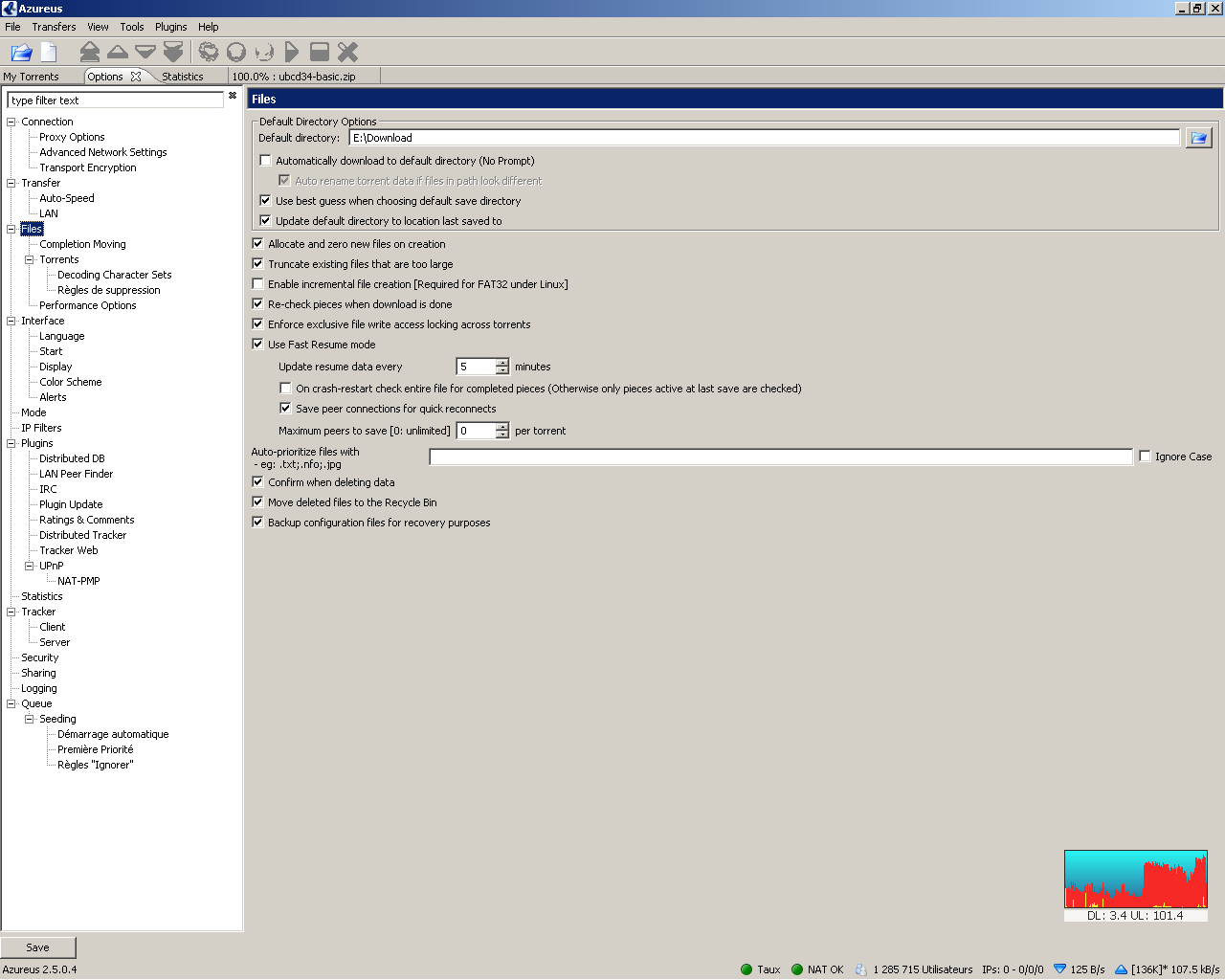
The choice of the download options is mostly a matter of personal taste, but the default settings are sound. My own choice of forcing an initial allocation of empty files is guided by the displeasure of discovering a disk space problem later during the download phase and to avoid chaotic disk work load (I like law and order here…) Then I want to have a systematic check of the downloaded files; If something went wrong, it is immediately detected and corrected by a couple of minutes more.
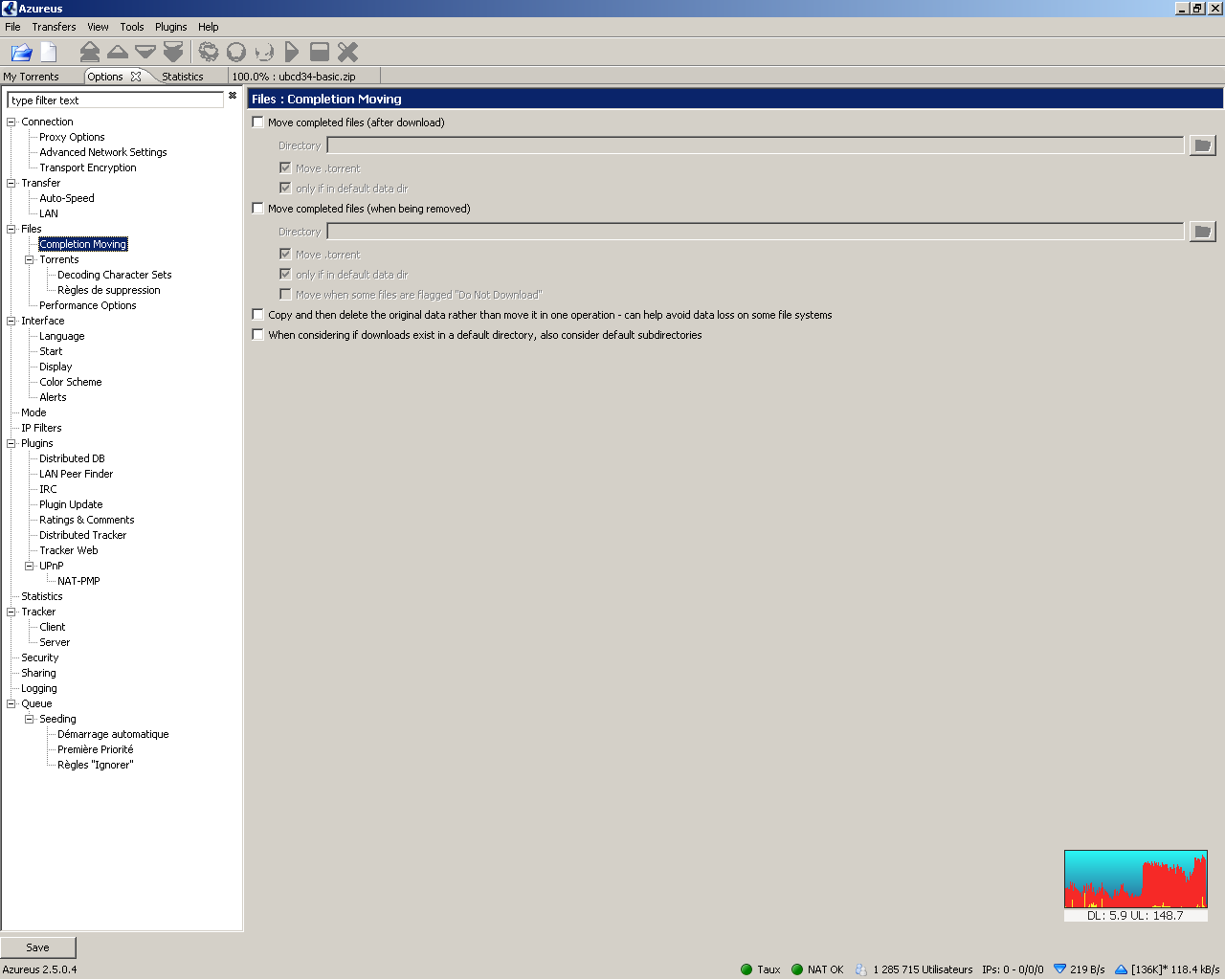
I don’t use this feature of moving files at the end of the download. If you want to put it somewhere else, why not put directly here instead of moving it later?
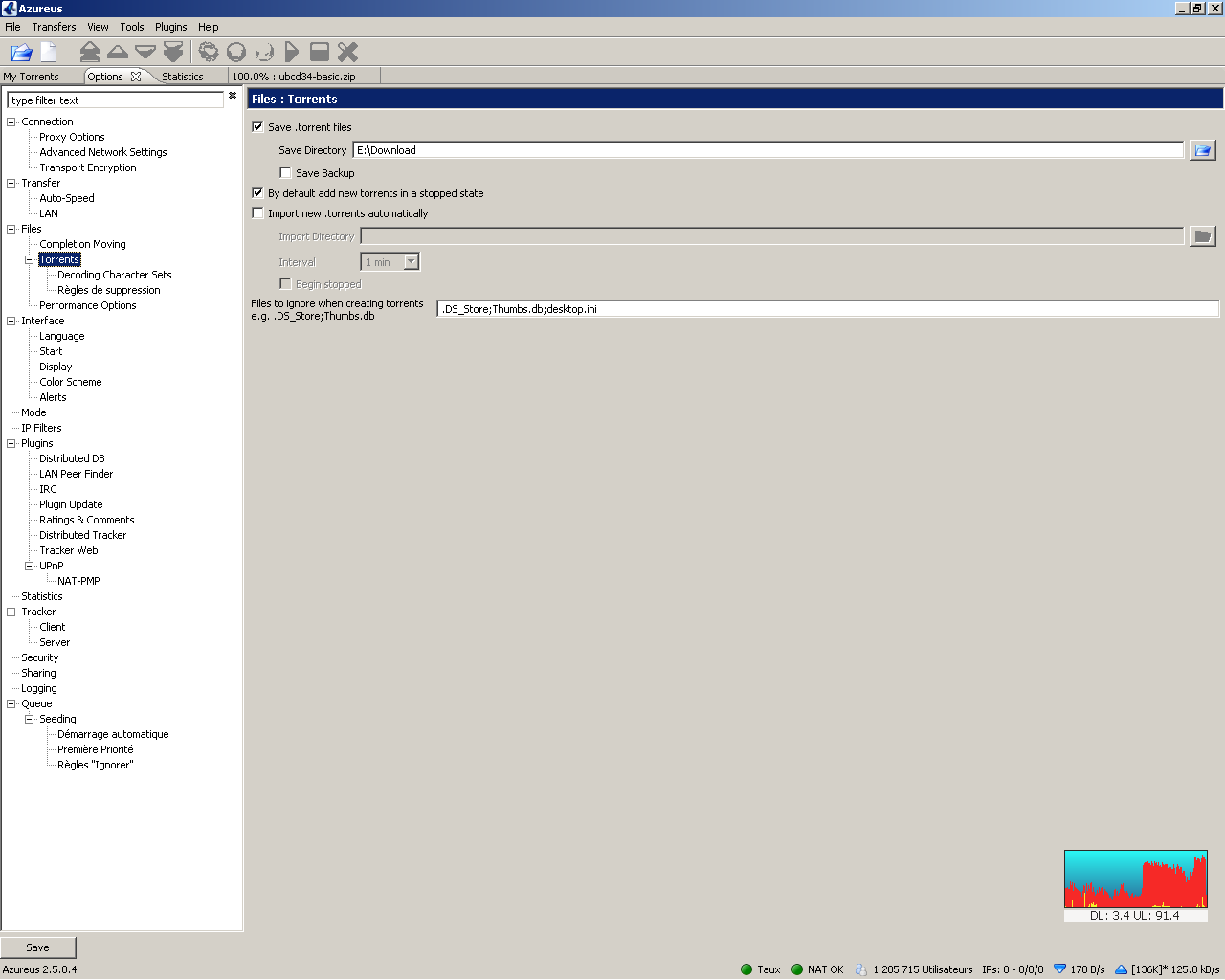
I store the torrents themselves in the same directory as the downloaded files (a metter of personnal taste indeed) and I do not start the downloads immediately (let’s wait for my own decision).
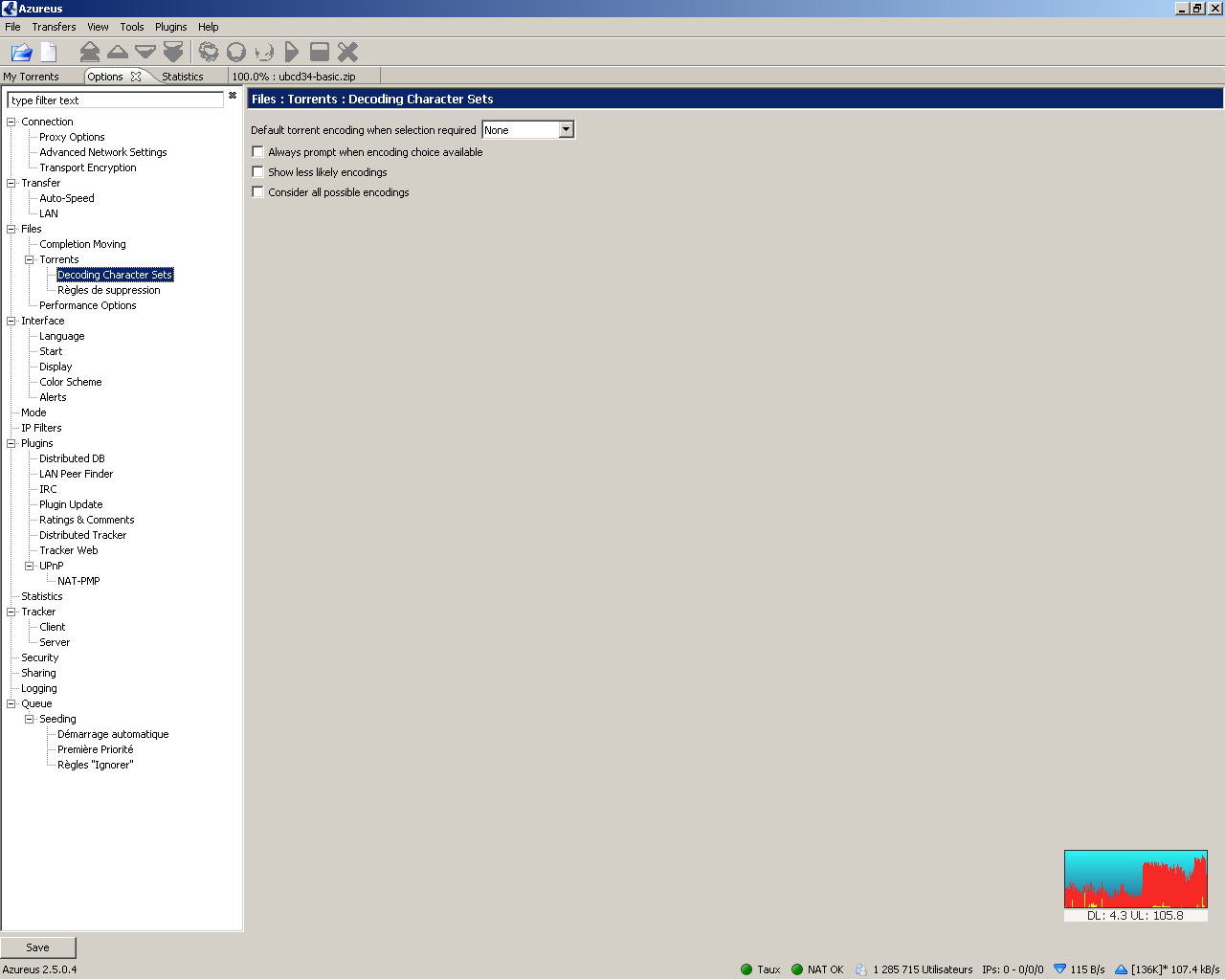
Without any opinion, I use the default options.
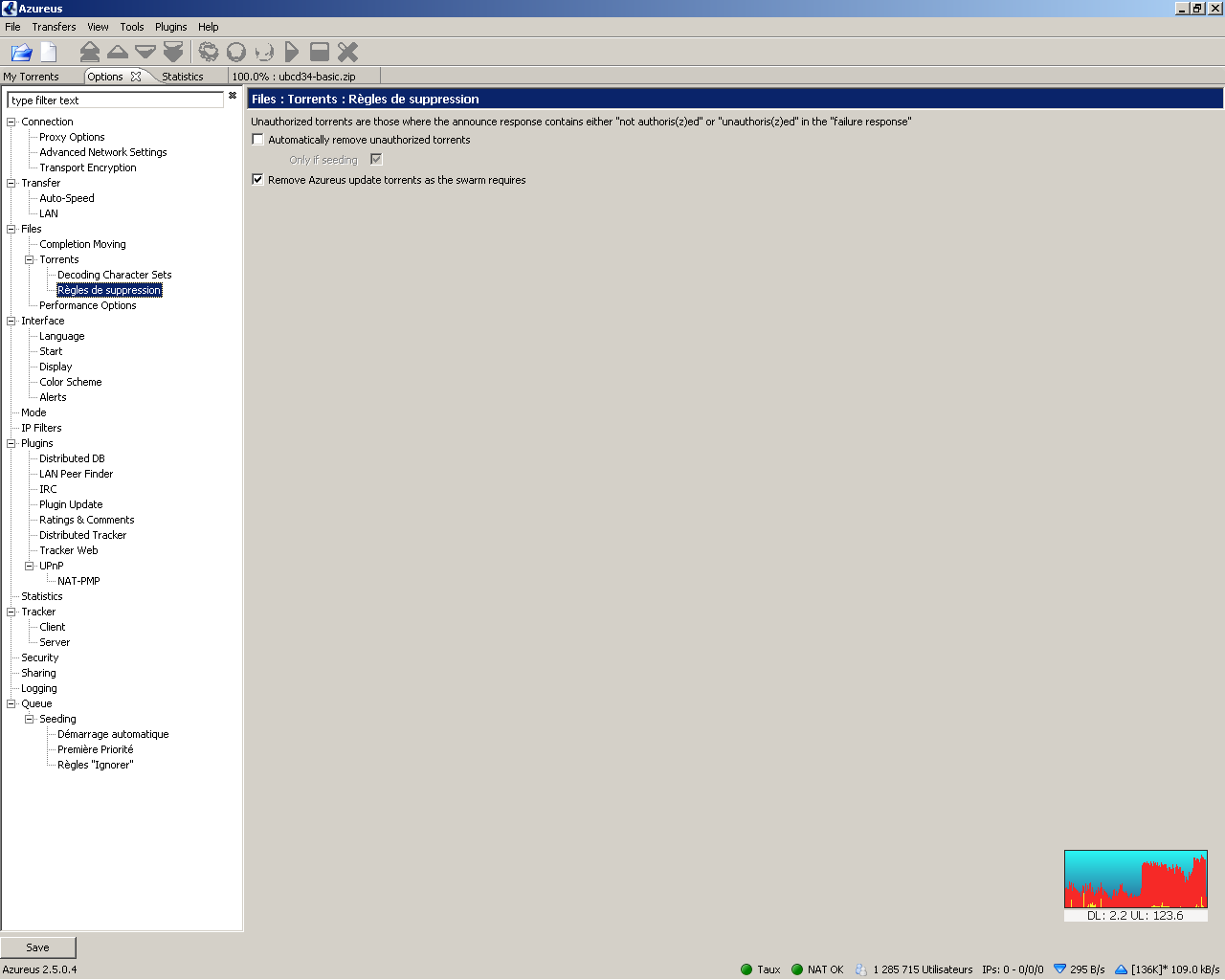
Why automatically suppress torrents? I prefer to do it by myself. The only exception is where Azureus is best-placed to decide.
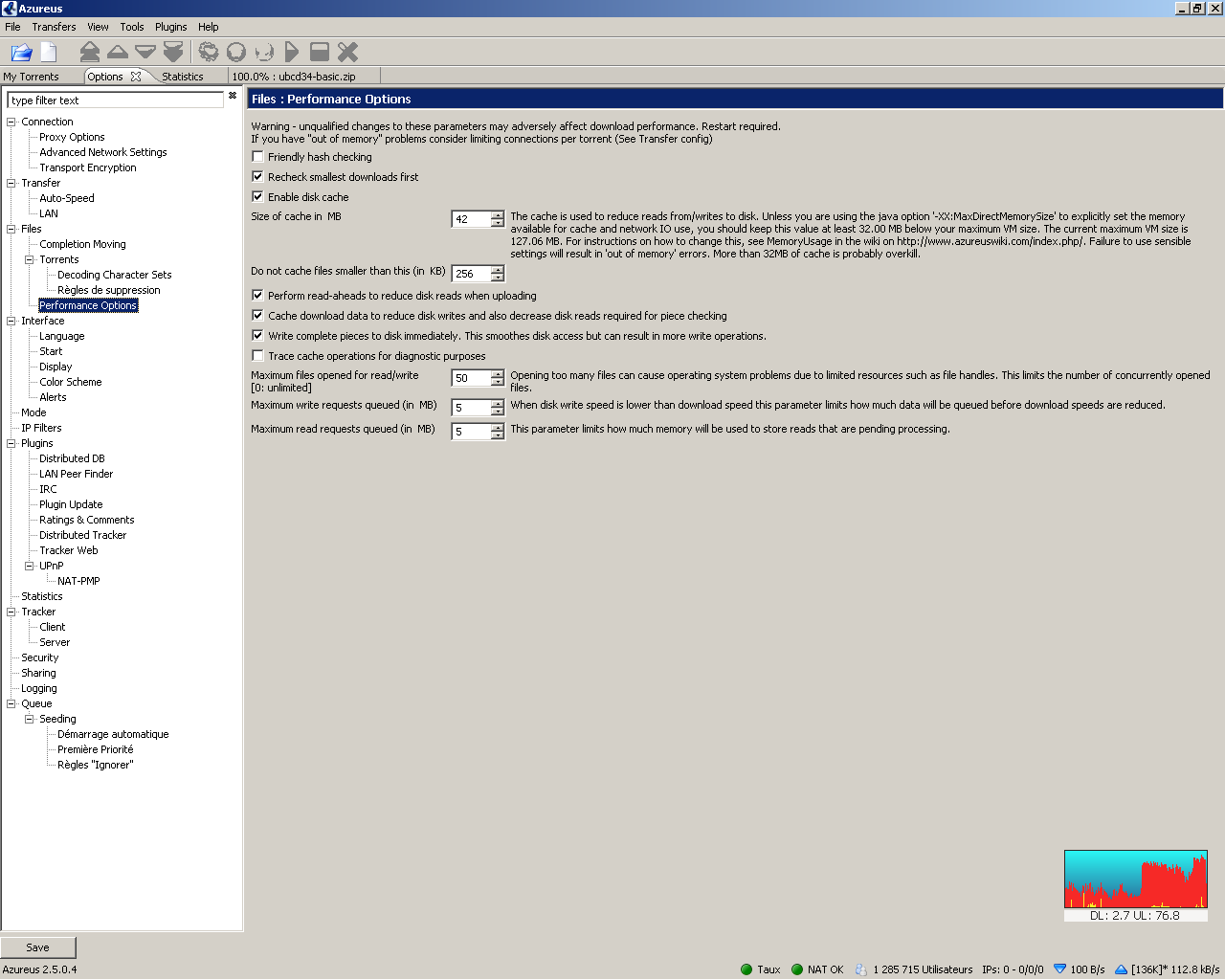
Slow hash checking would be less intense, but it leads to very long delays for this important operation with my Athlon 2600+ on files sized by the hundreds of MB.
For the size of the disk cache, I followed the advice given by Azureus on the same page.
The other performance choices are either default values, or small modifications I did to favor a little PC like mine.
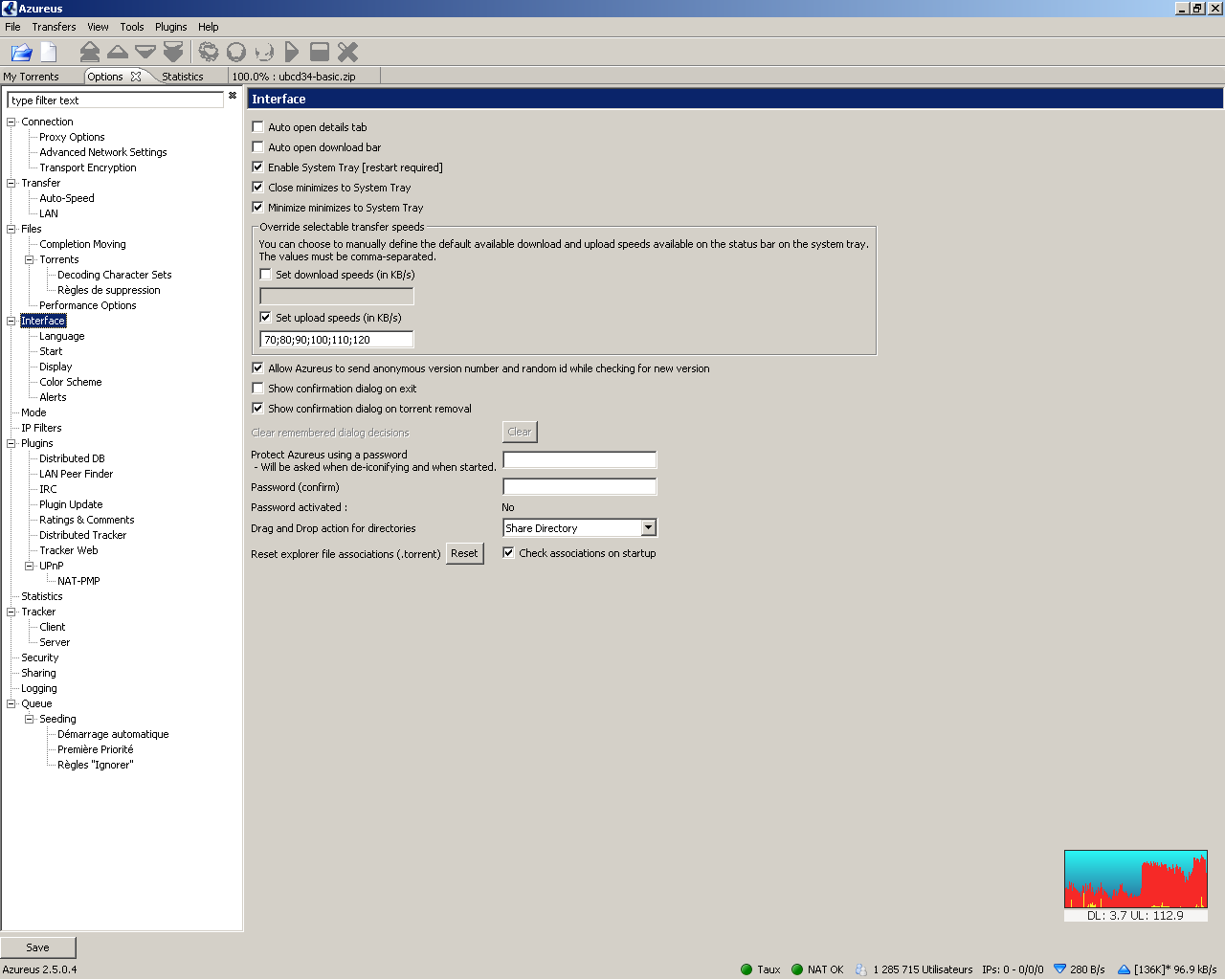
Human interface options should have no impact on the performance, but will influence your access to Azureus. The list of the upload speeds is built to provide a reasonable set of values in the menu that is appearing when you right-click on the upload speed at the bottom right of the window.
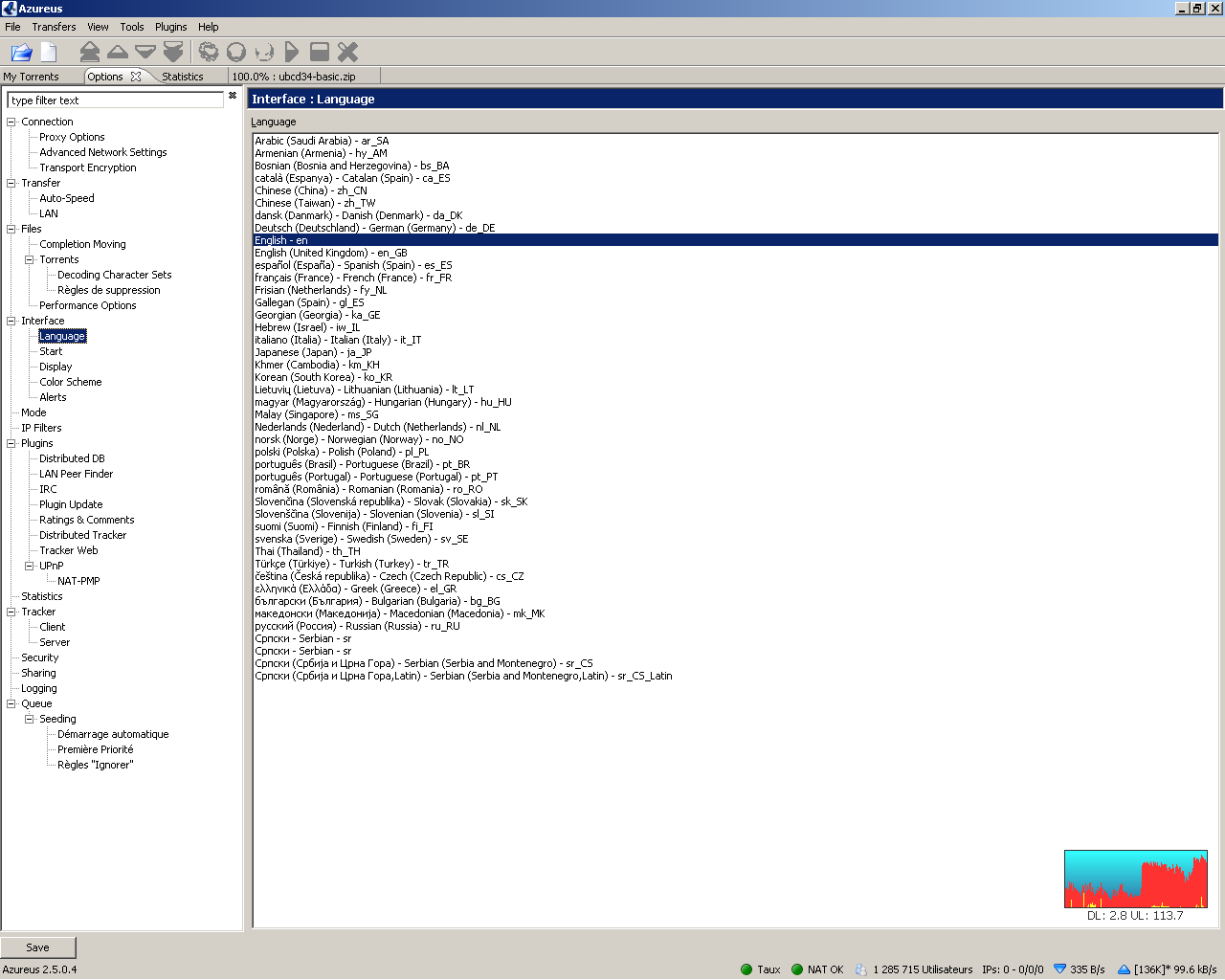
A lot of choice for the language. Yours is certainly here, but the translations are not always 100% finished (e.g. in French about 10 messages have been forgotten – or added later).
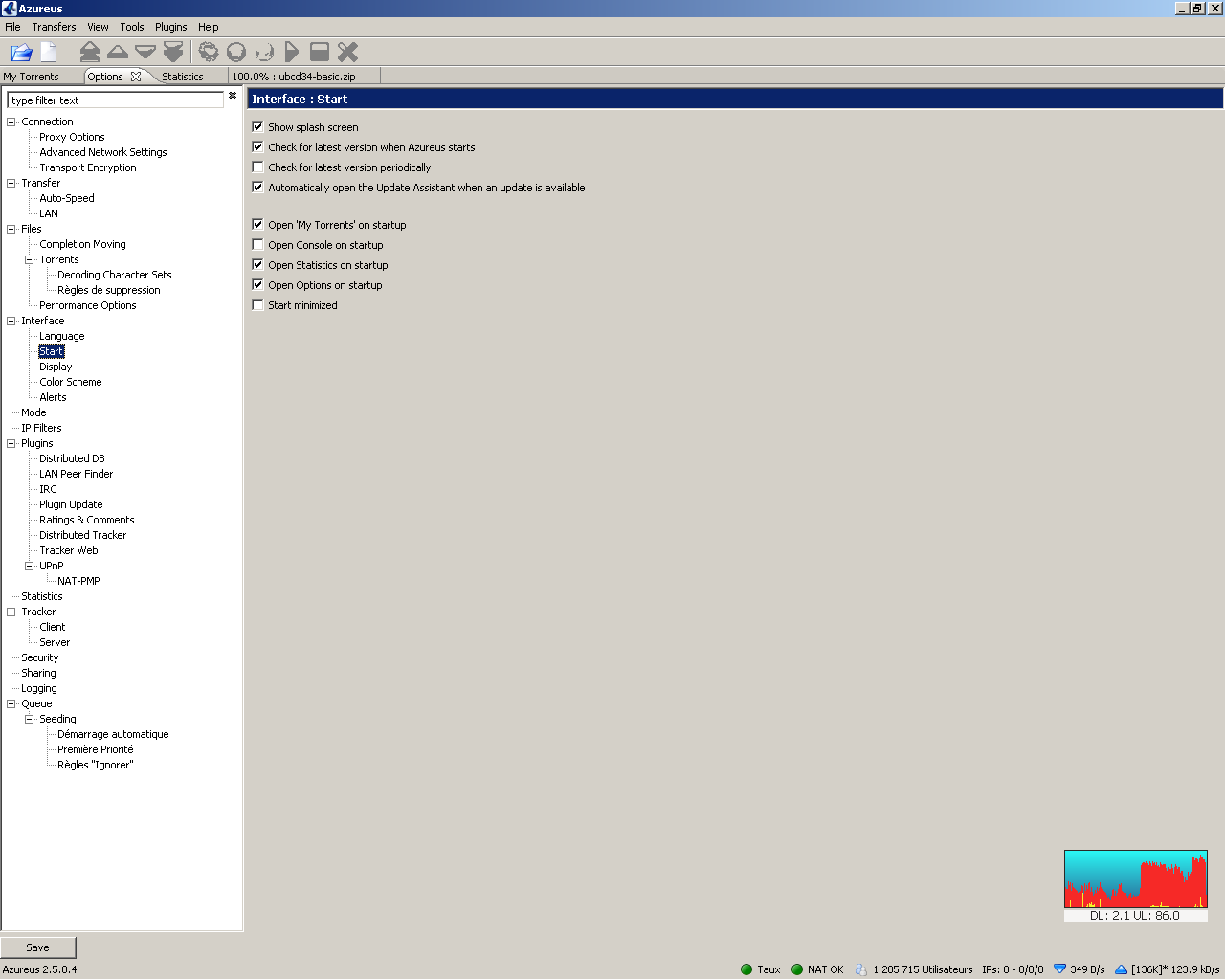
I don’t like to be at the receiving end of too many message firing (I don’t want the latest version of software applications; I want the one that works well and is debugged). On the contrary, I want direct access to the three important windows:
- My torrents
- Options (Isn’t it the only thing we’re discussing here?)
- Statistics (because it is nice and it fascinates me)
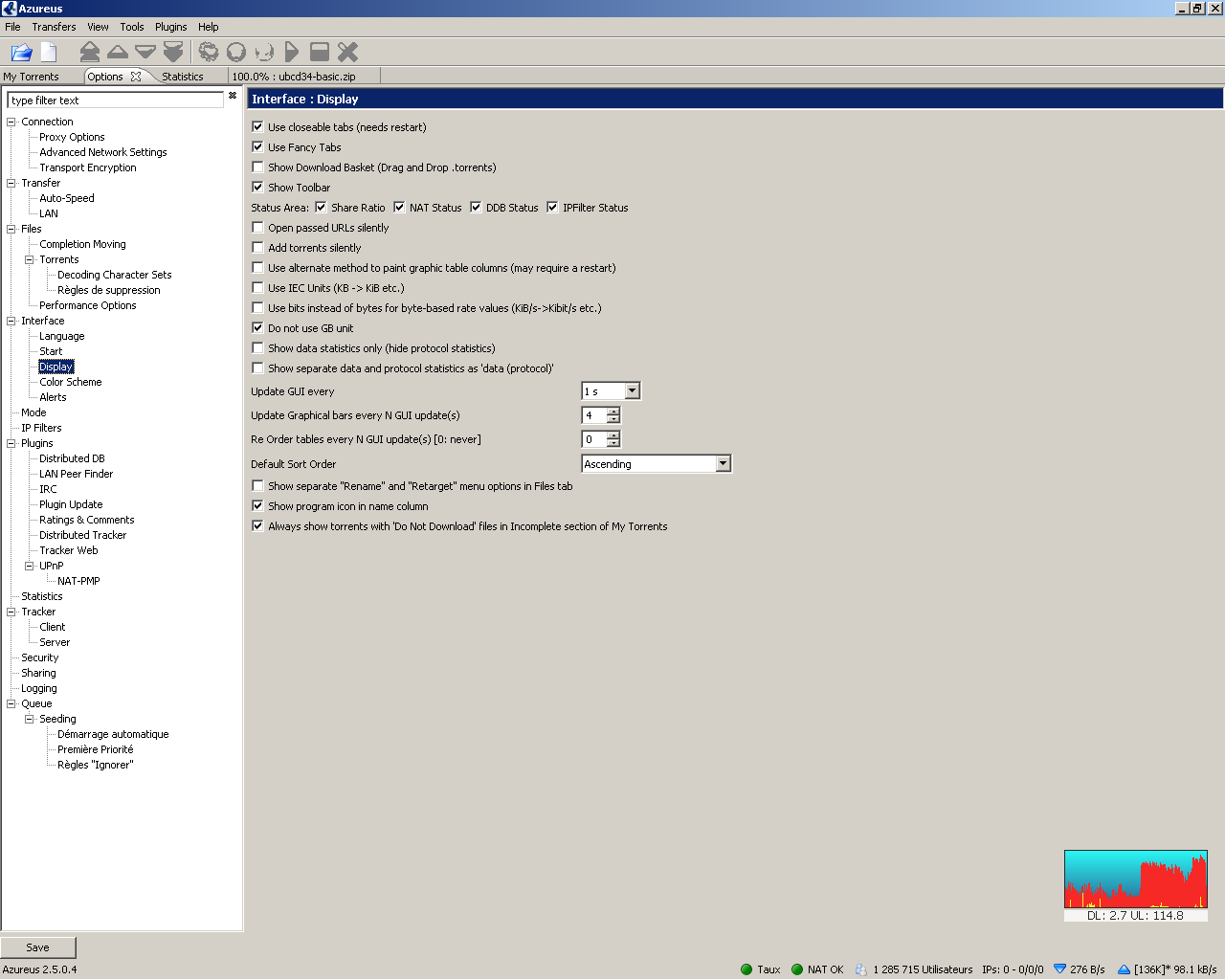
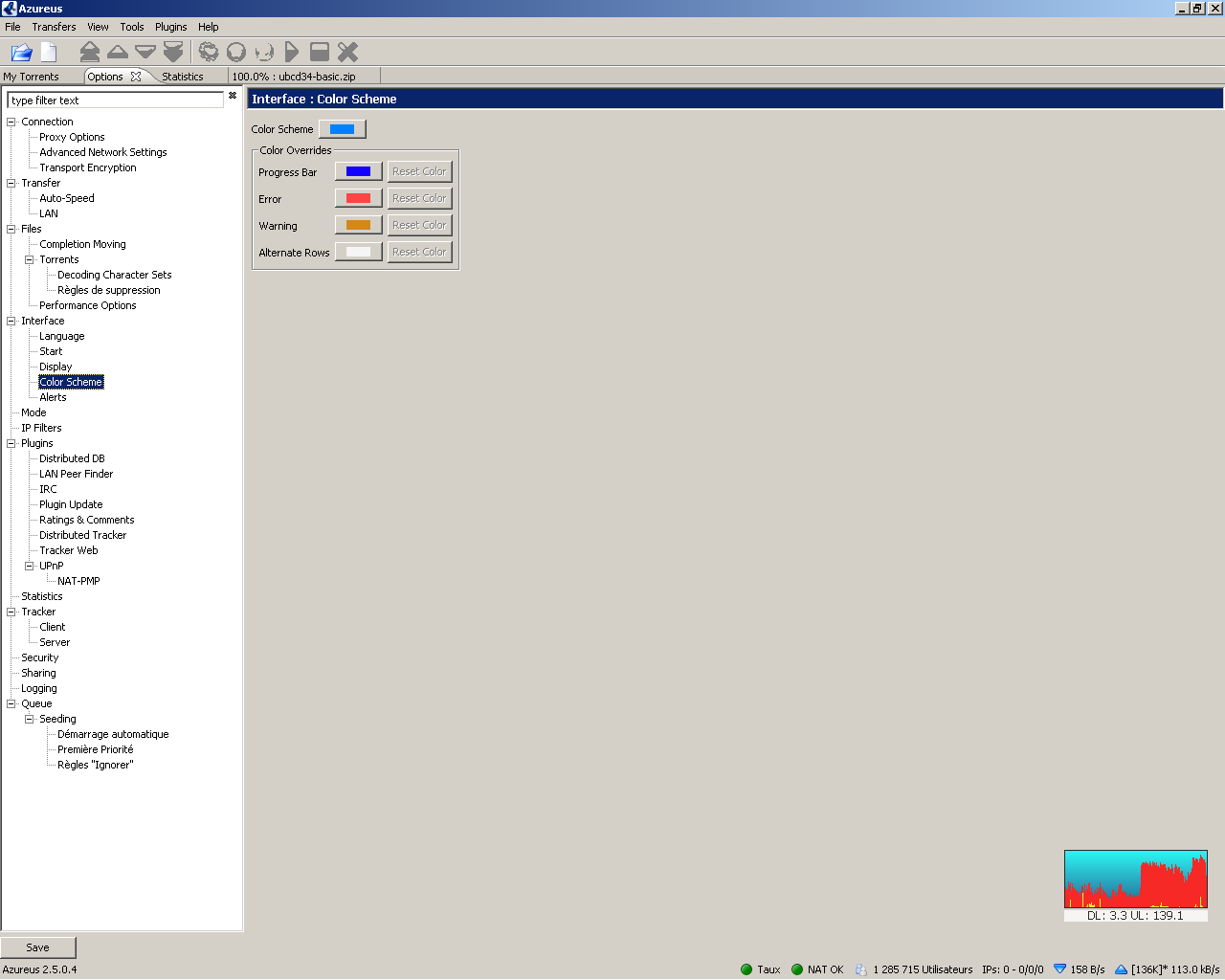
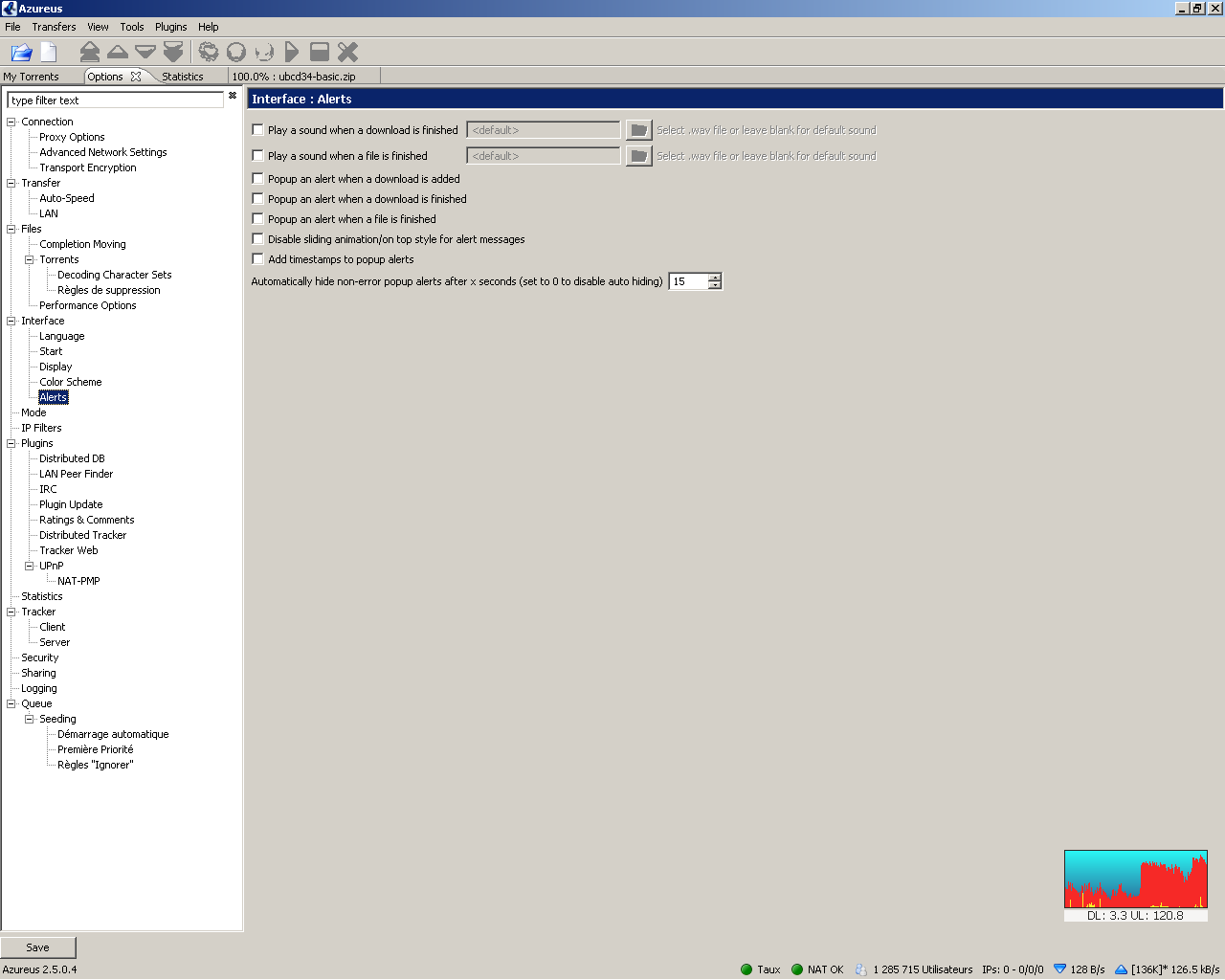
I hate all those alerts…
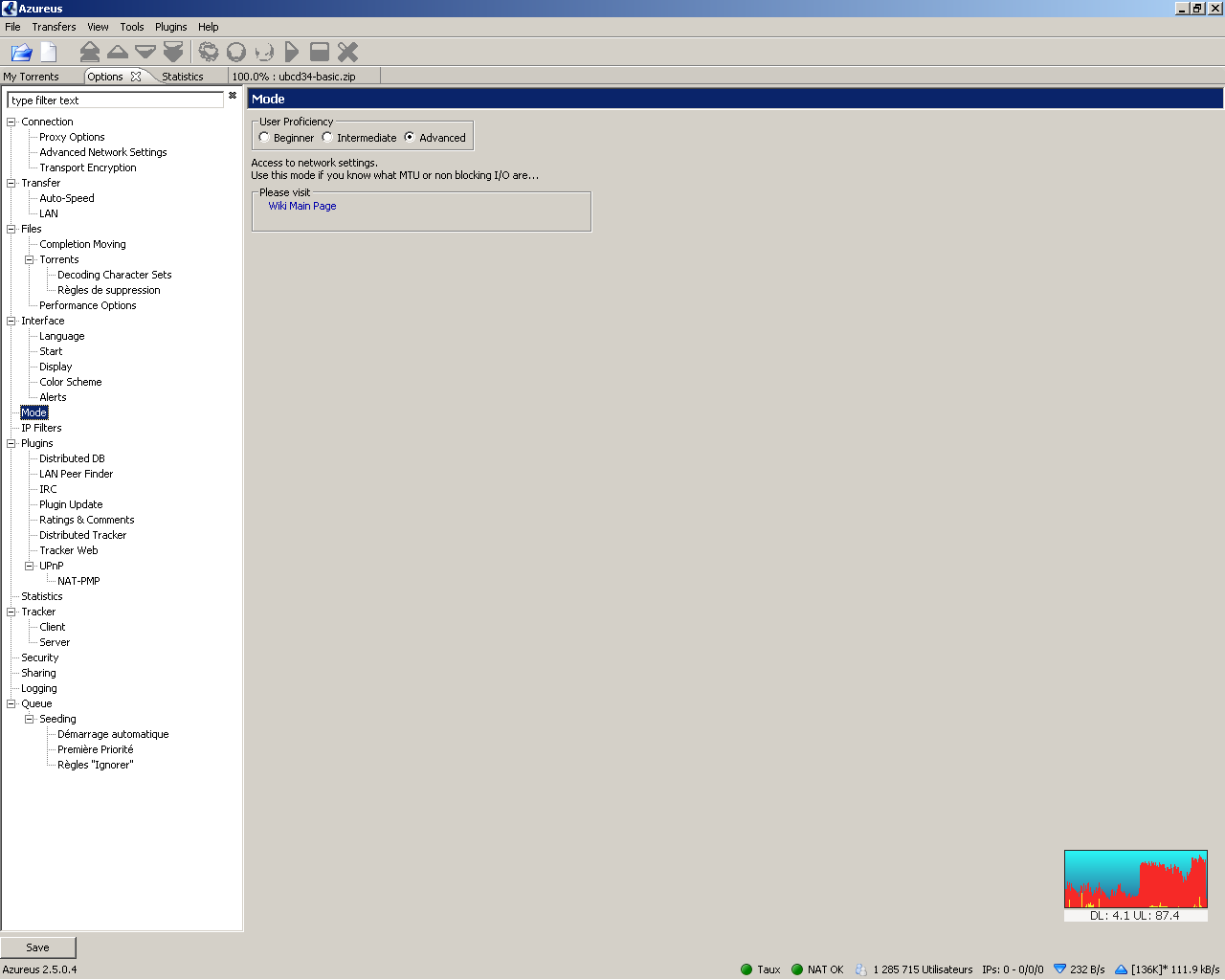
I chose “avanced” indeed. But if you choose another mode, you will have less flexibility than here.
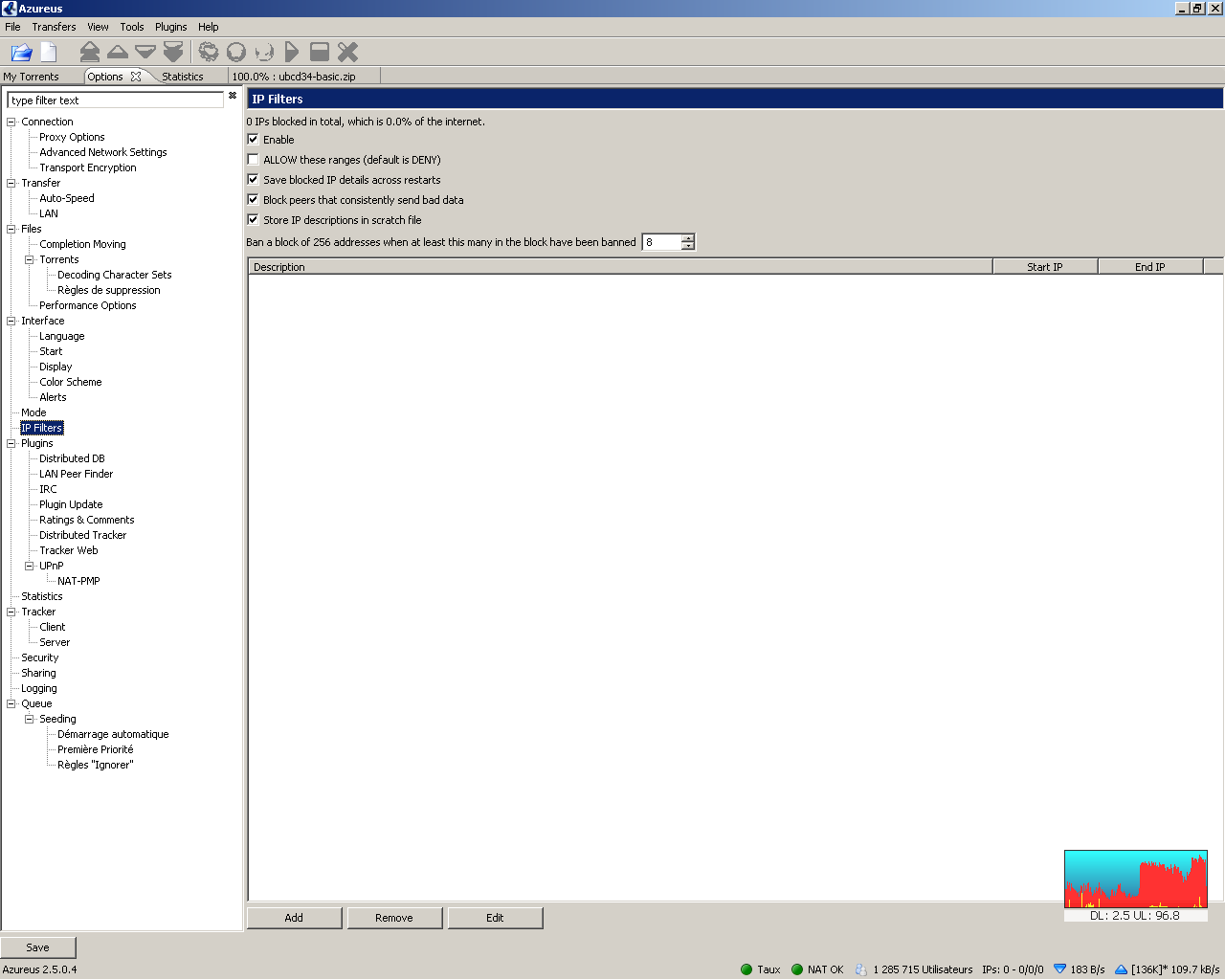
No IP filter, but I may switch opinions. About this, I would be glad to hear your own opinion. Are filters really useful or a matter of mere paranioa?
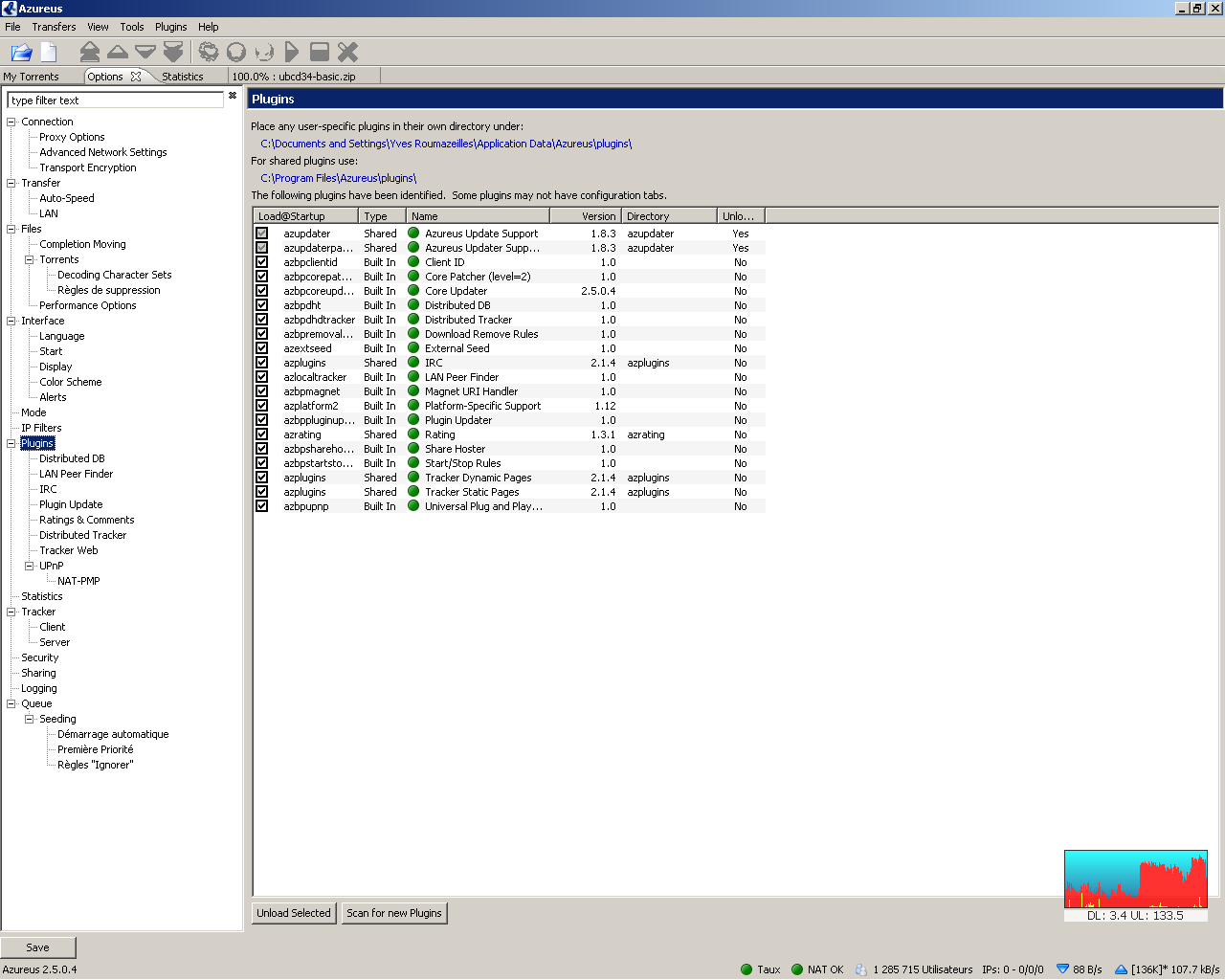
Only default plugins are installed.
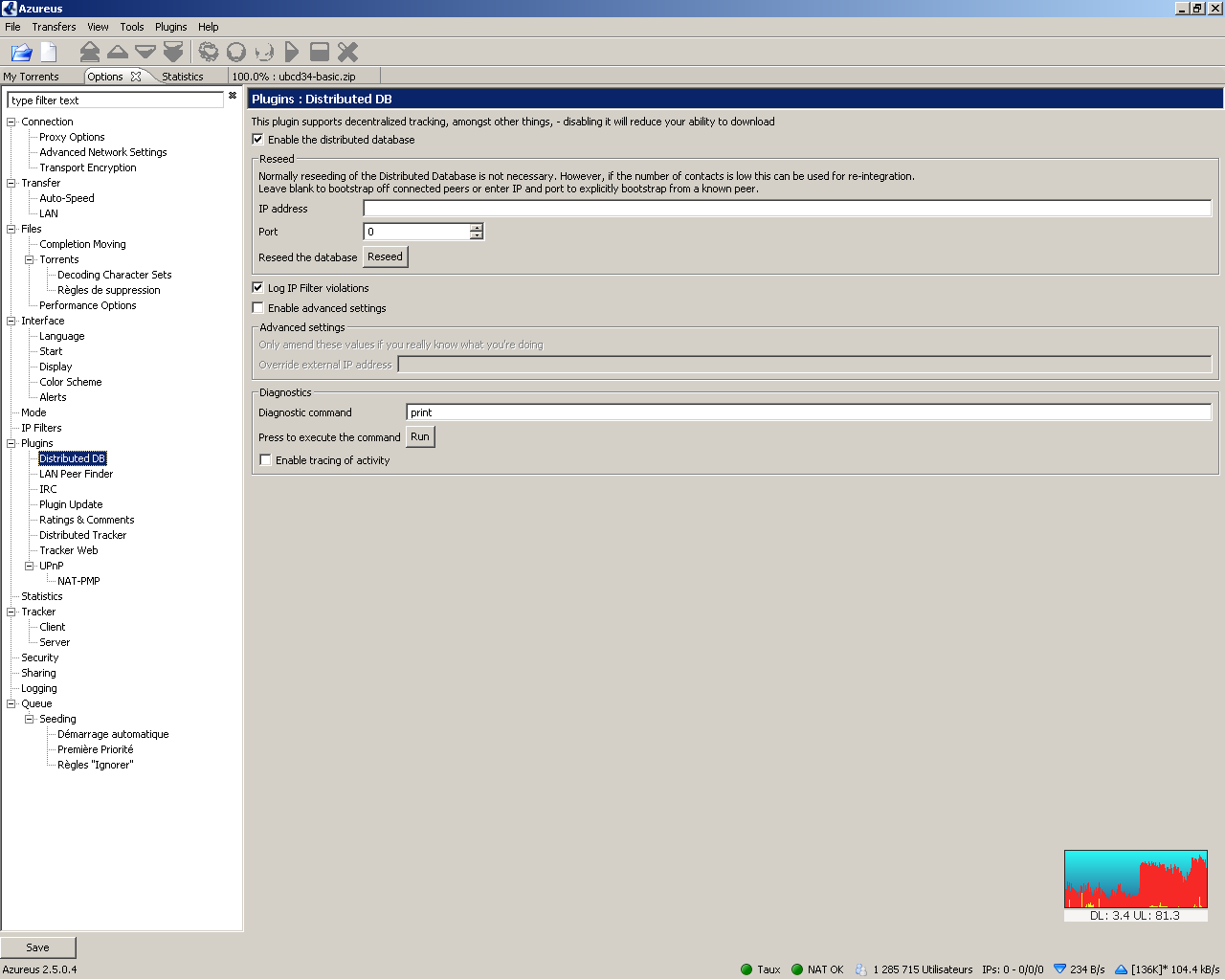
As told, it’s better to participate to the distributed database to improve downloads. It increases the number of visible peers and the download speed. Moreover, it helps in starting torrents.
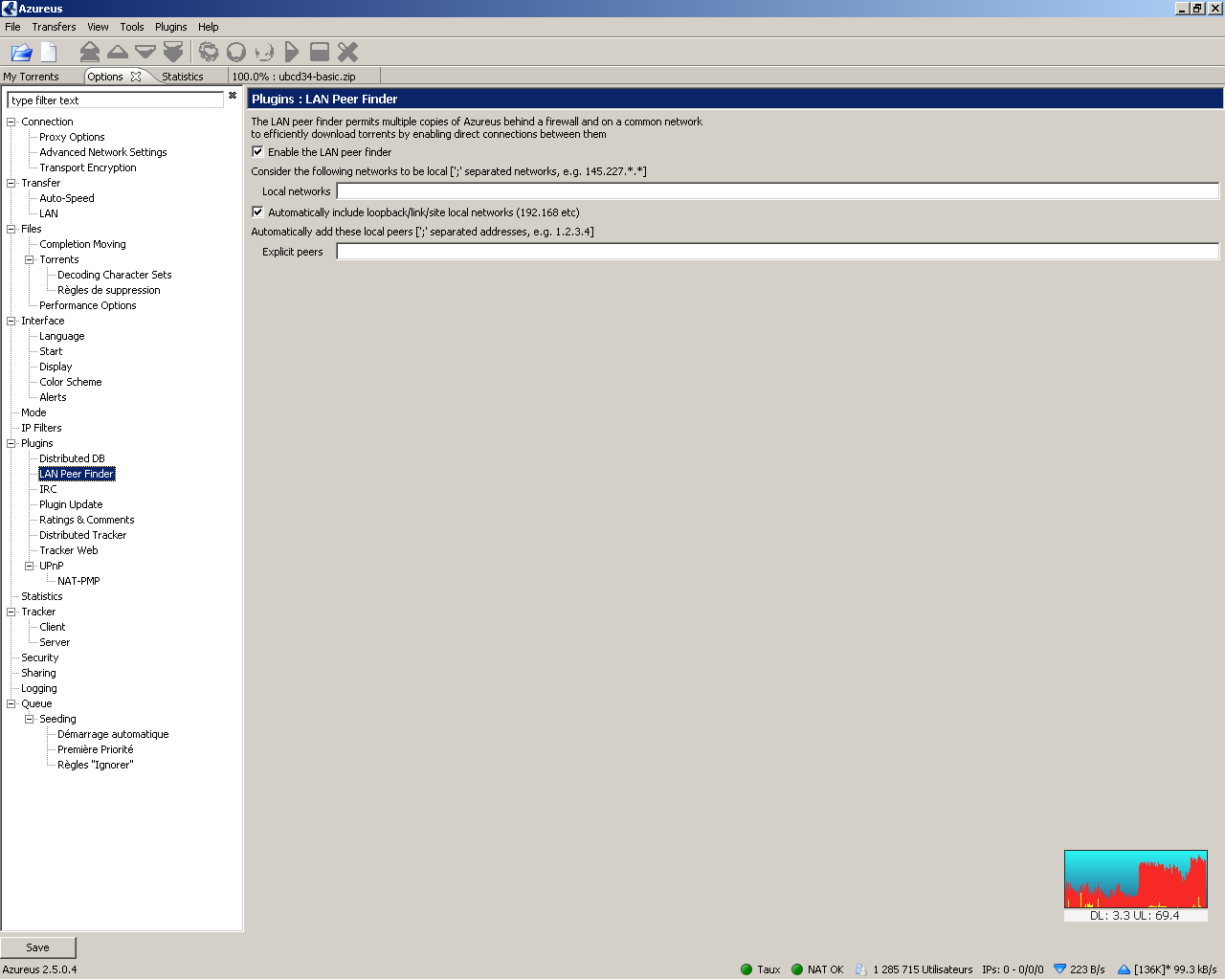
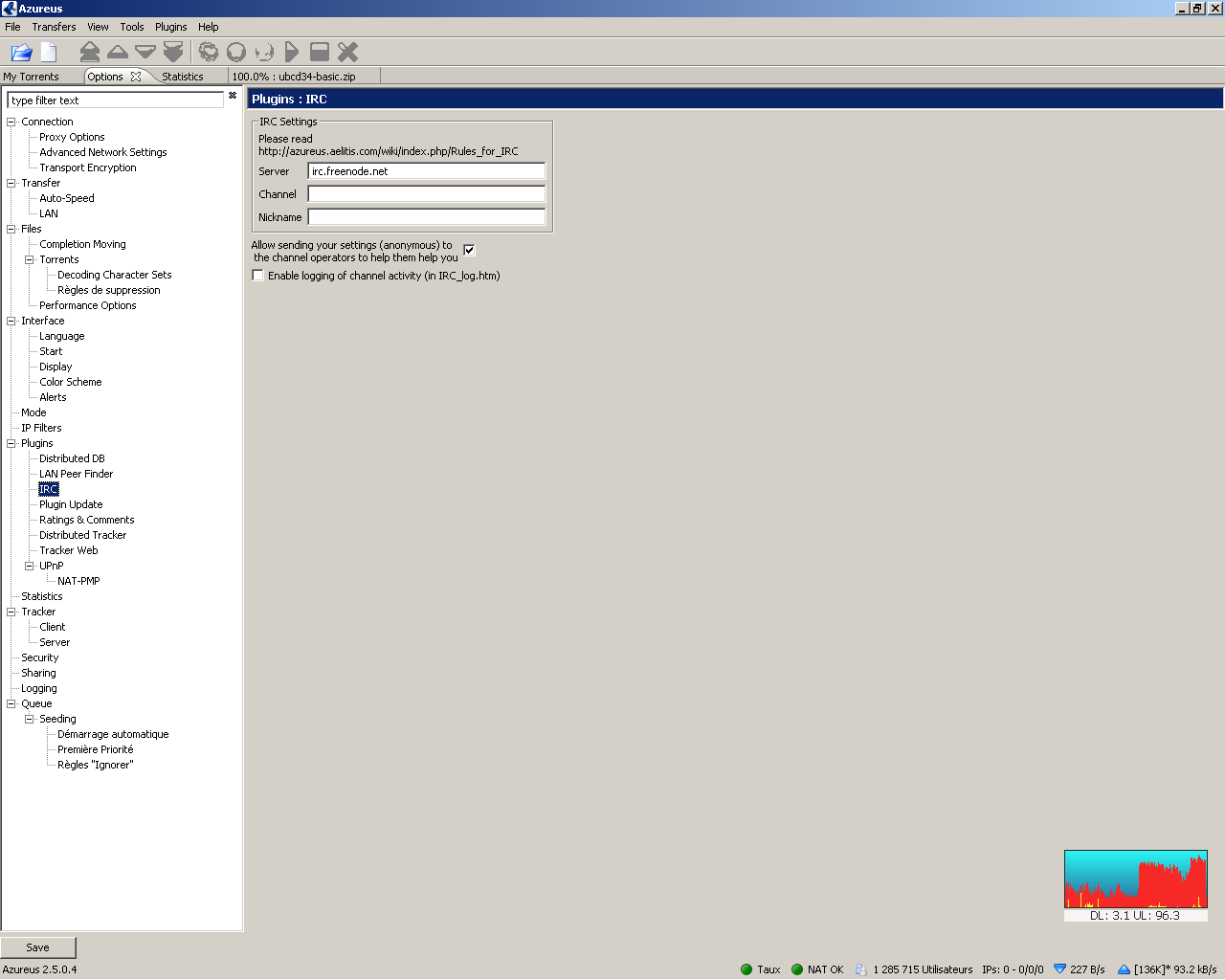
I don’t use IRC (too much complication for so little a benefit: You have to dig randomly to find poorly visible torrents and it’s only interesting to hunt illegal or very recent videos).
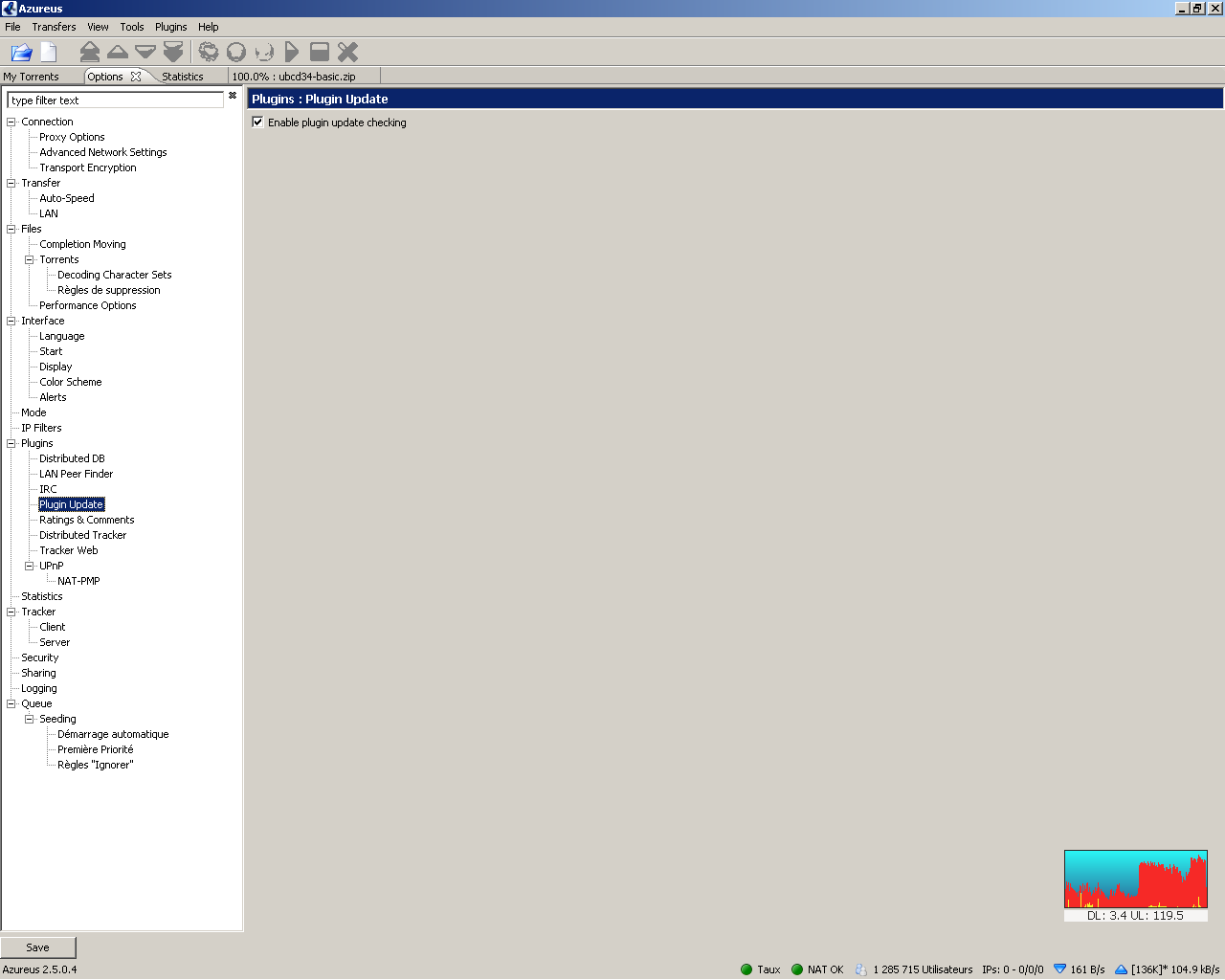
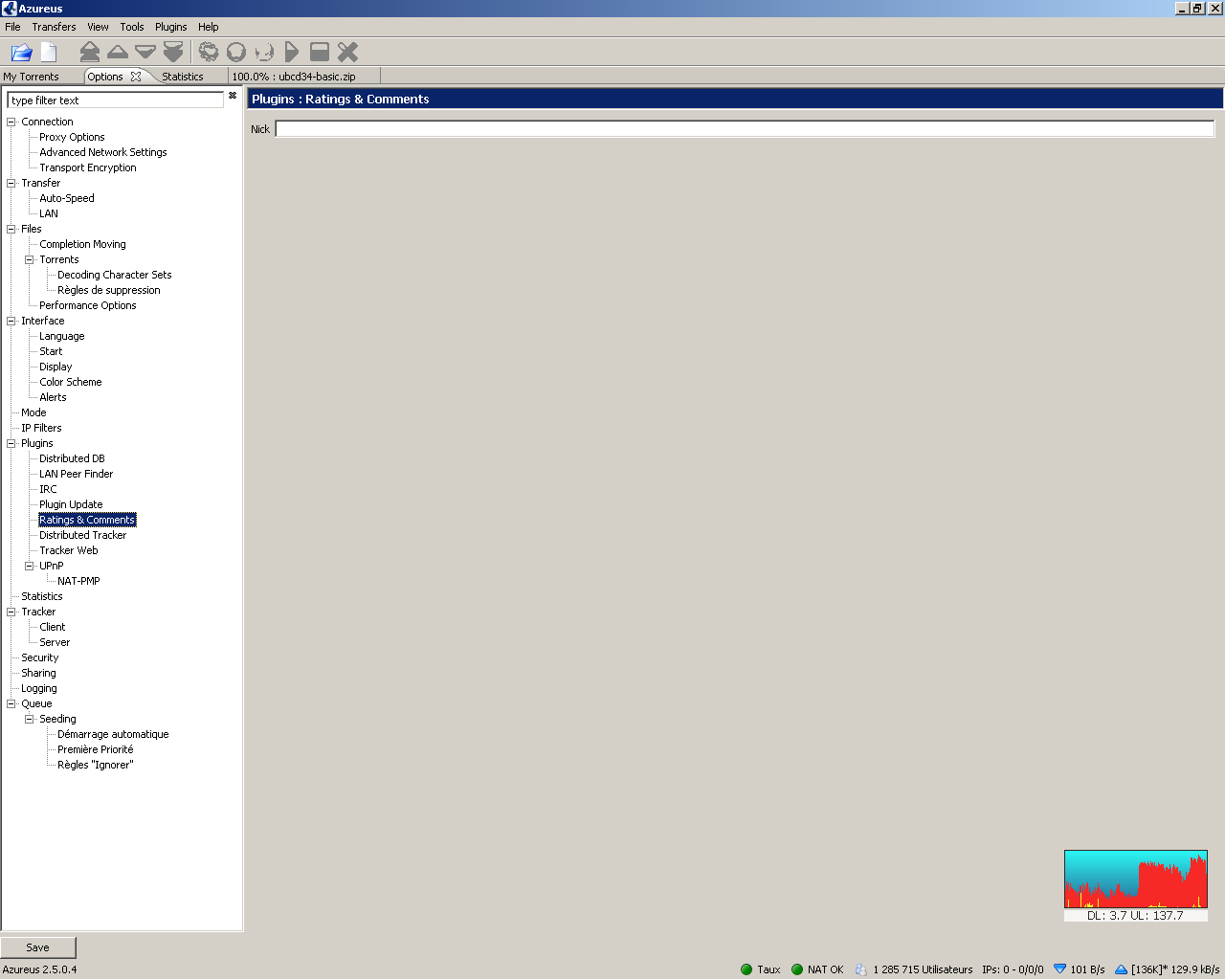
I don not comment on torrents. I don’t need a nickname or pseudo.
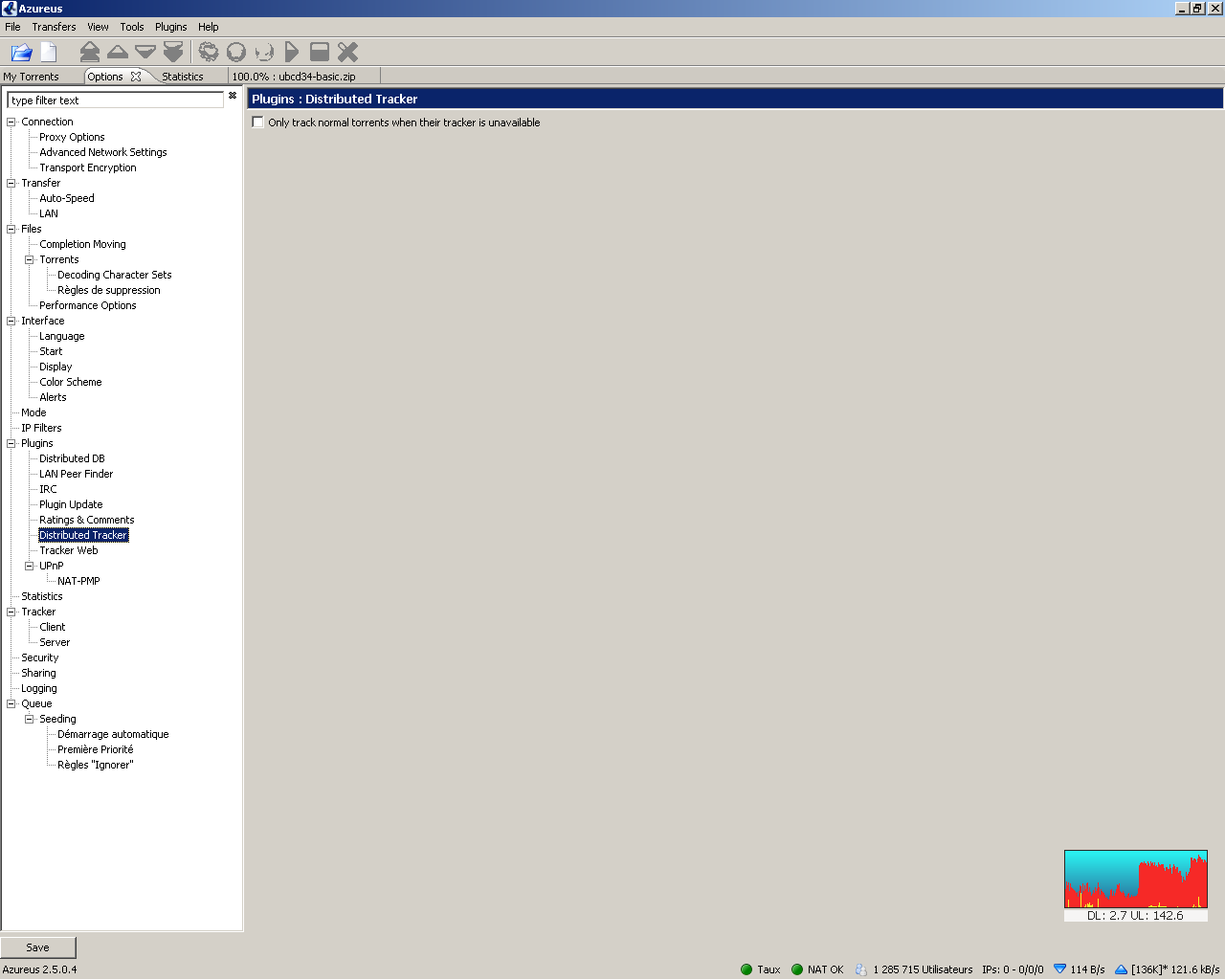
I still prefer to use the distributed tracker as often as possible. It should be an improvement on download speed, I unclick the setting.
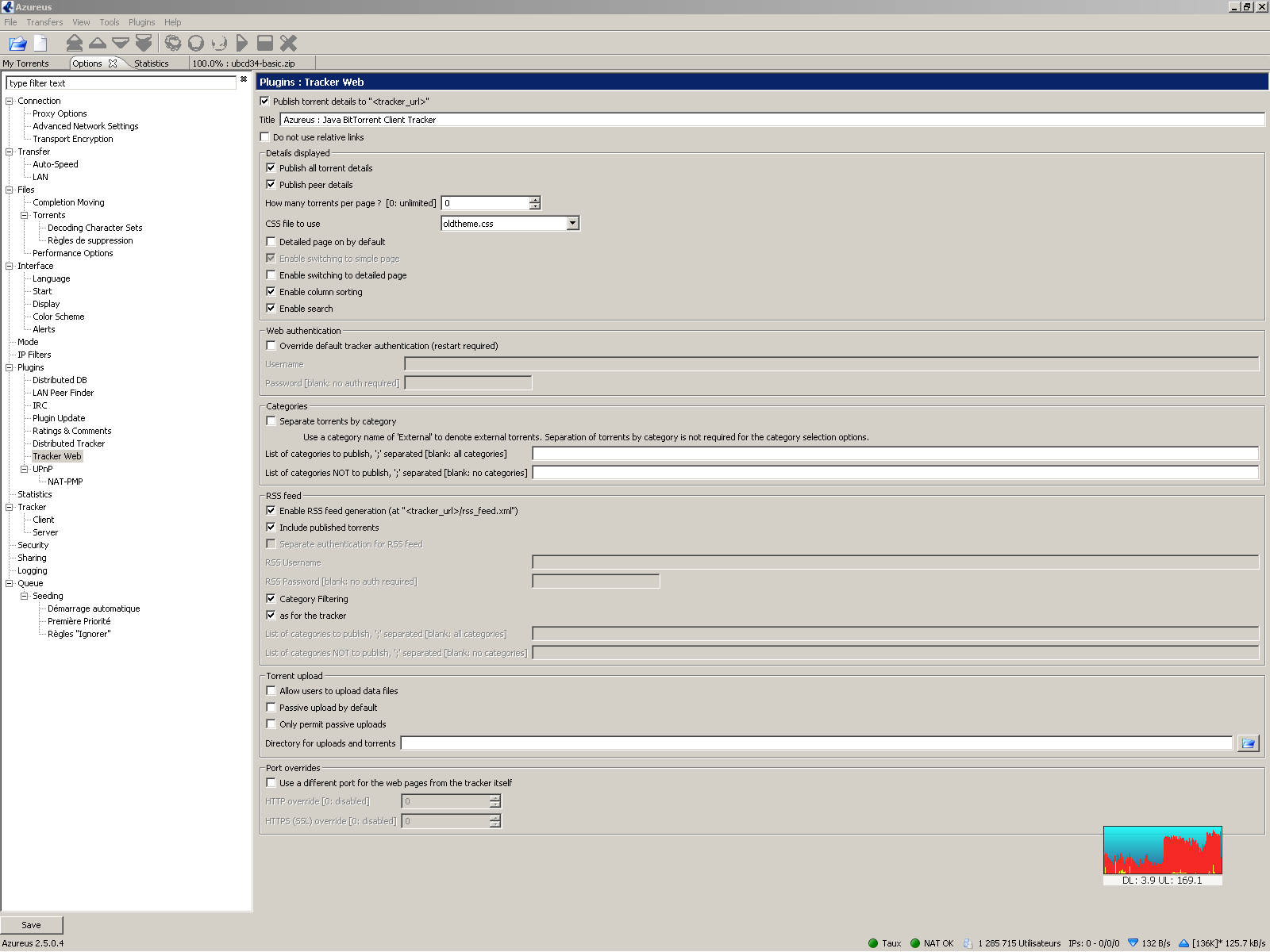
I don’t intend to manage my own tracker (or to publish my own files either). I did not even try to setup categories.
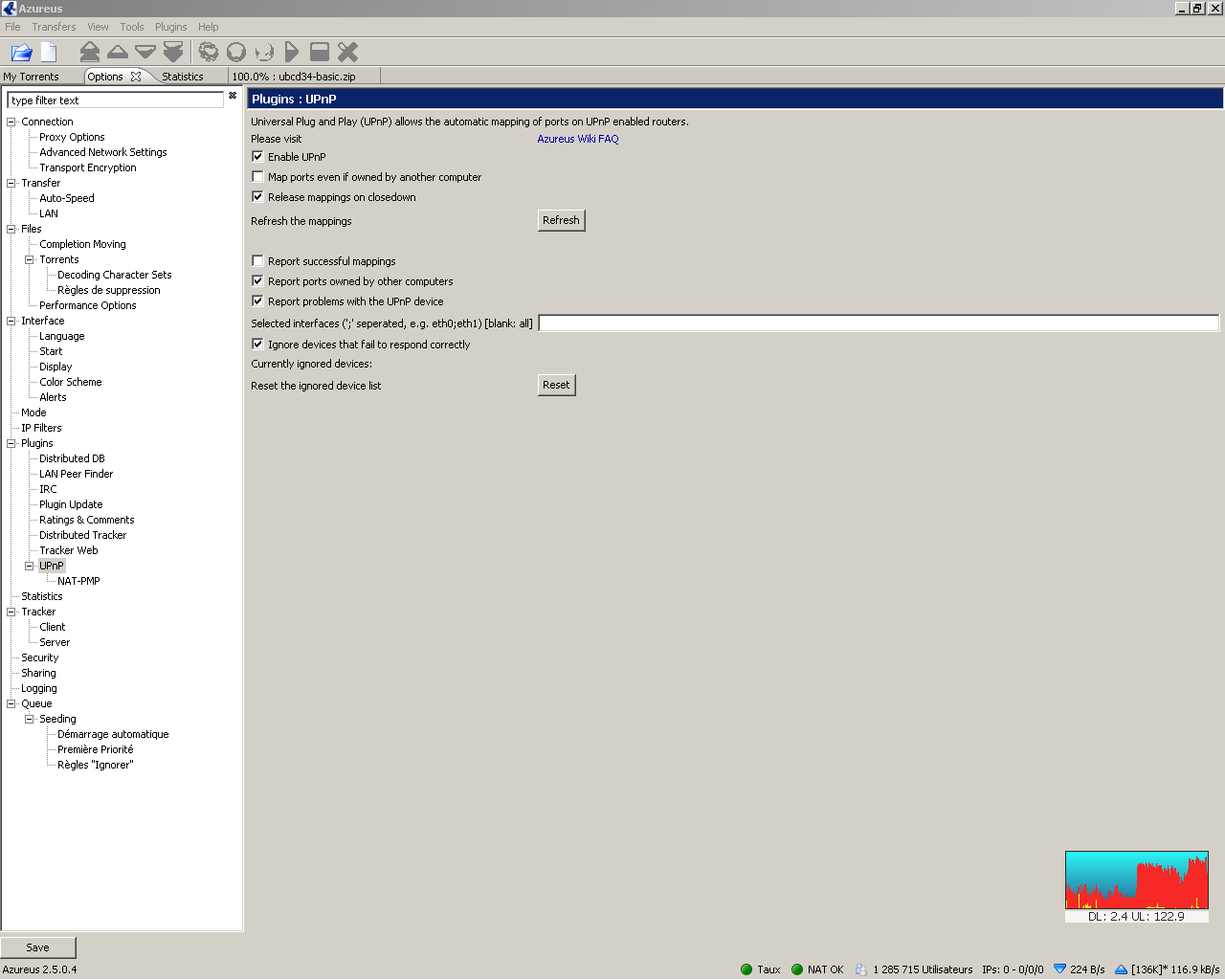
I did not touch this since I believe that uPnP only works for Windows XP. Anyway, I perceive no influence.
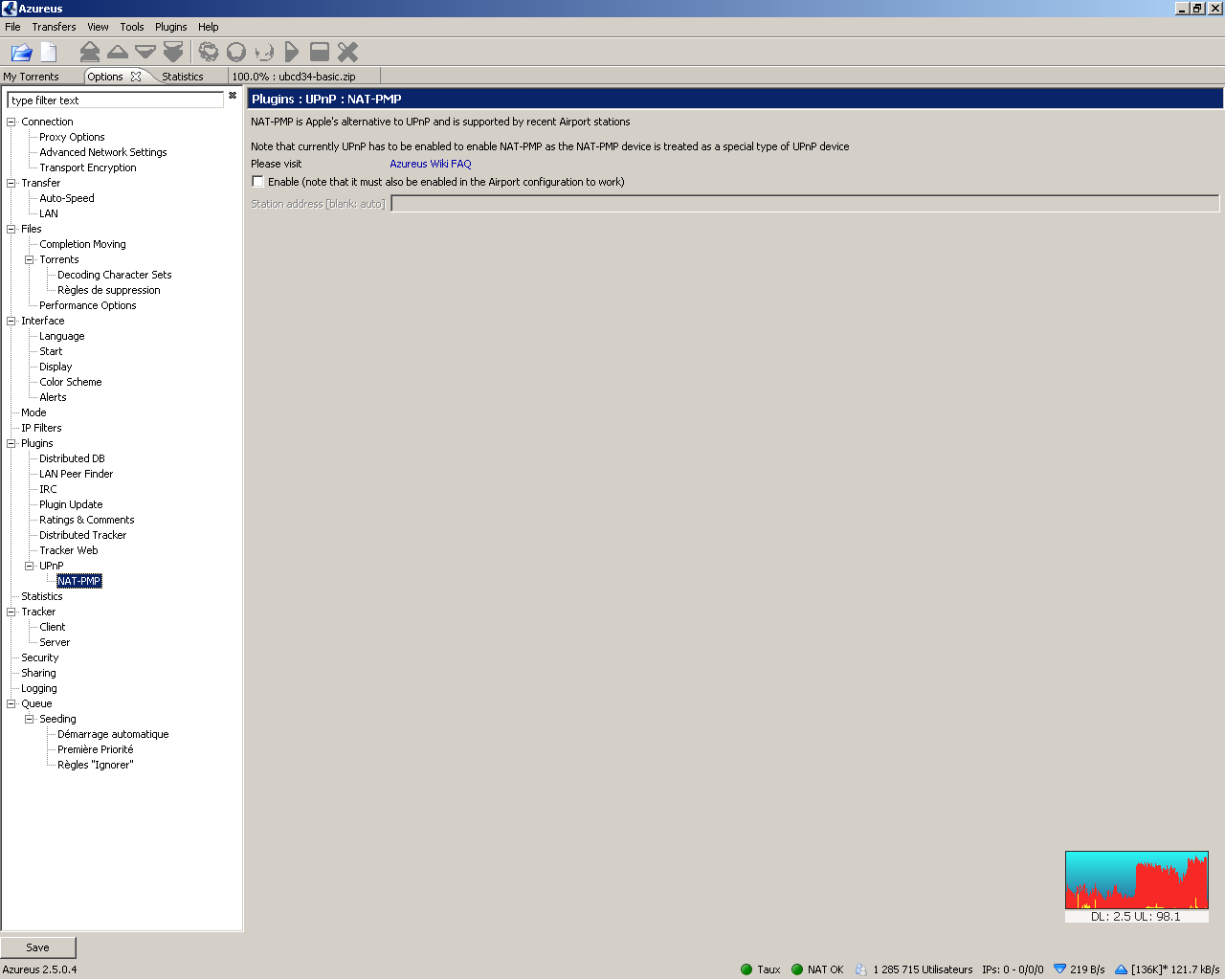
I’m on a PC, no Apple Mac.
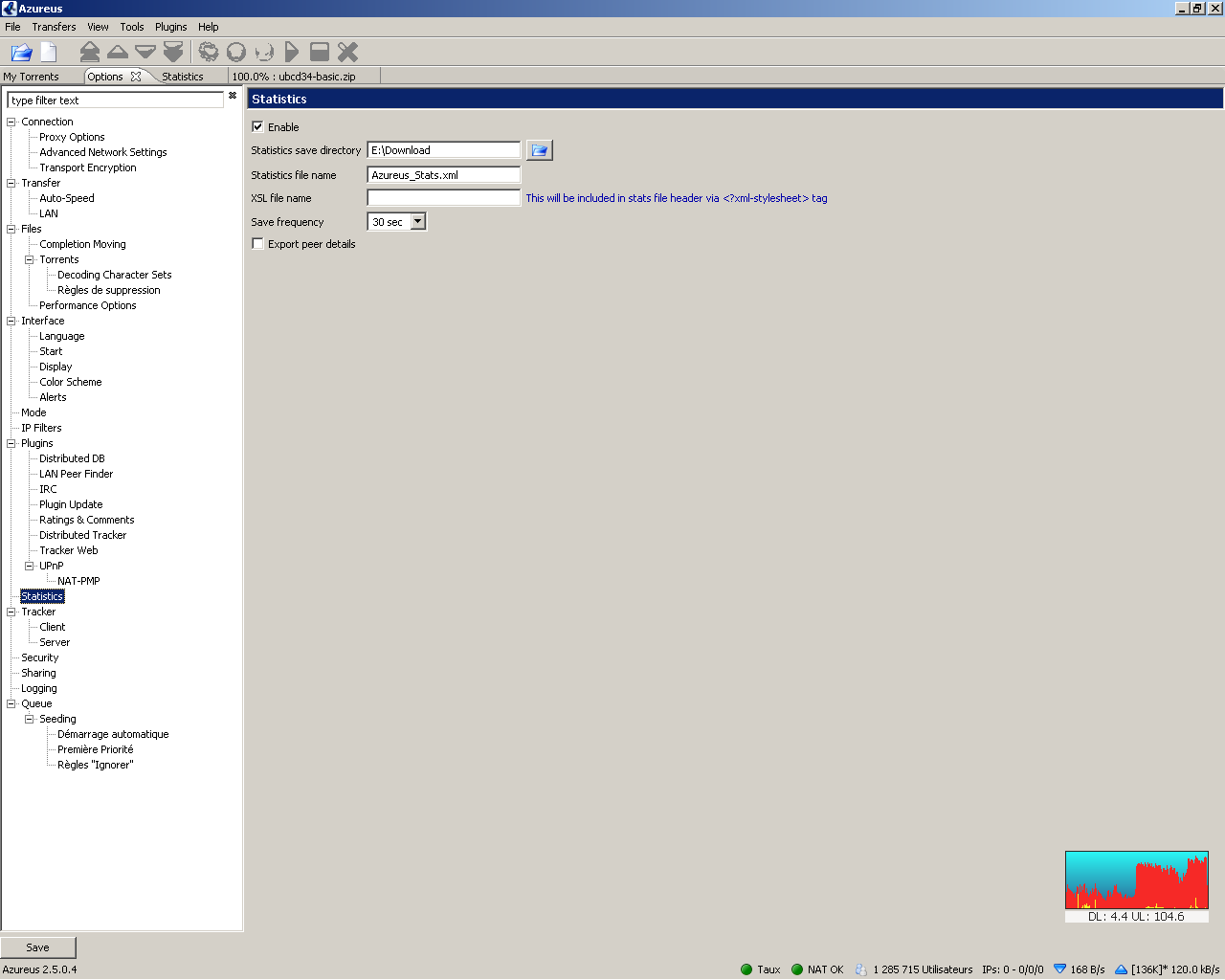
I activated statistics because I love to have data to understand things and because the available graphs are fascinating (a little like the cobra snake is fascinating for its victim staying stunned in front of the predator’s sight :-).
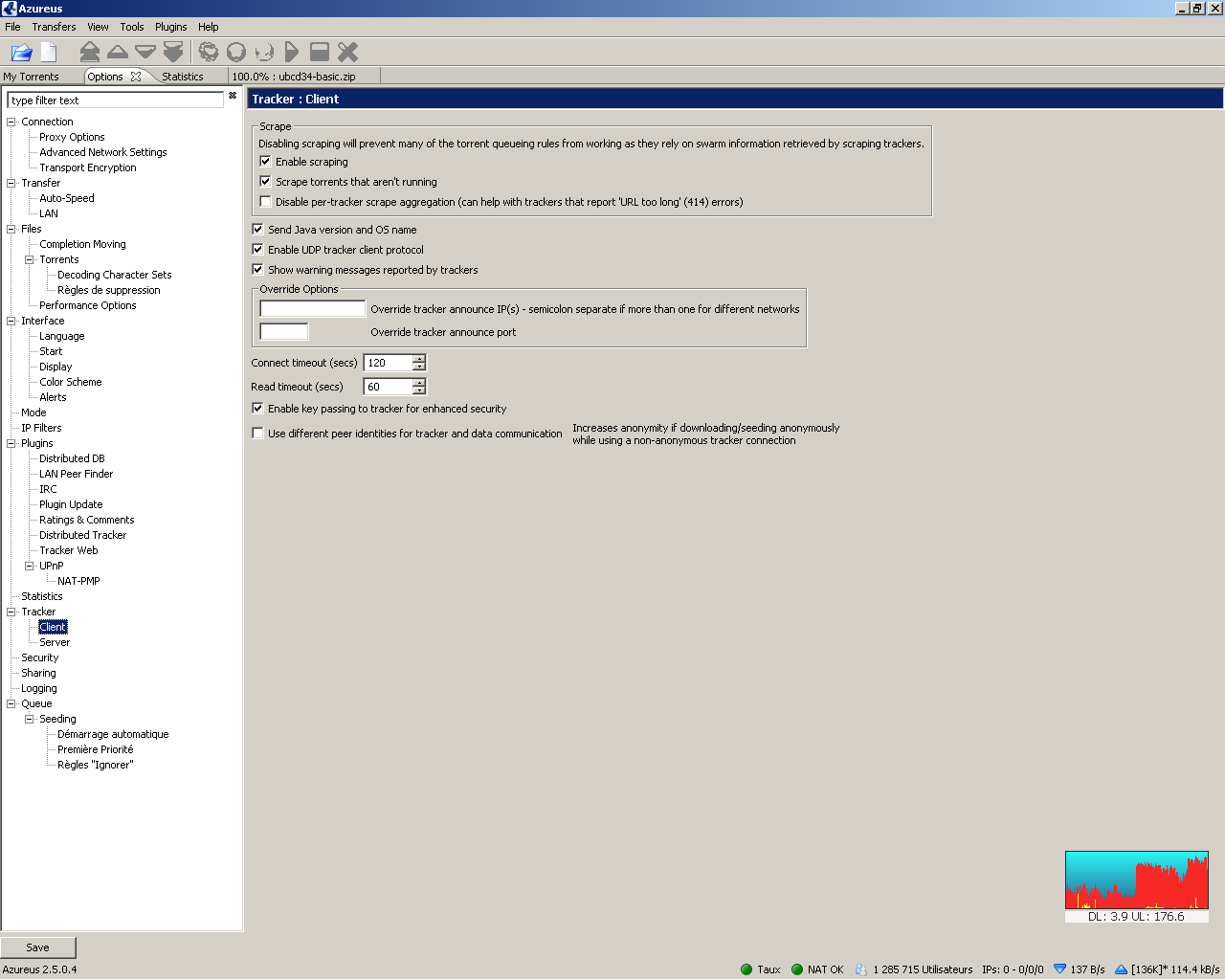
I believe that torrent sorting according to scrape rules has a small impact on network optimisation. I activate it.
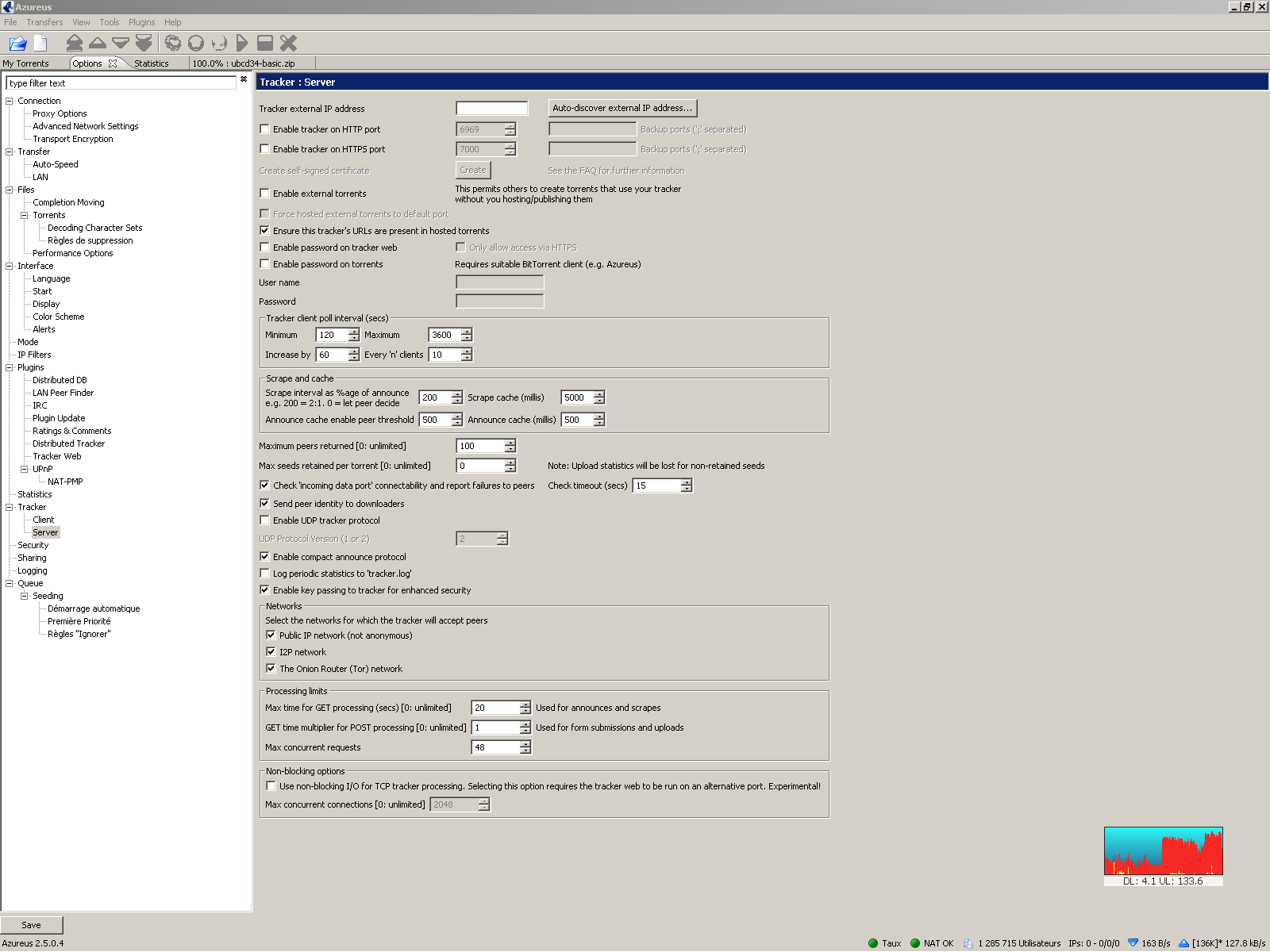
No tracker here. No setting there.
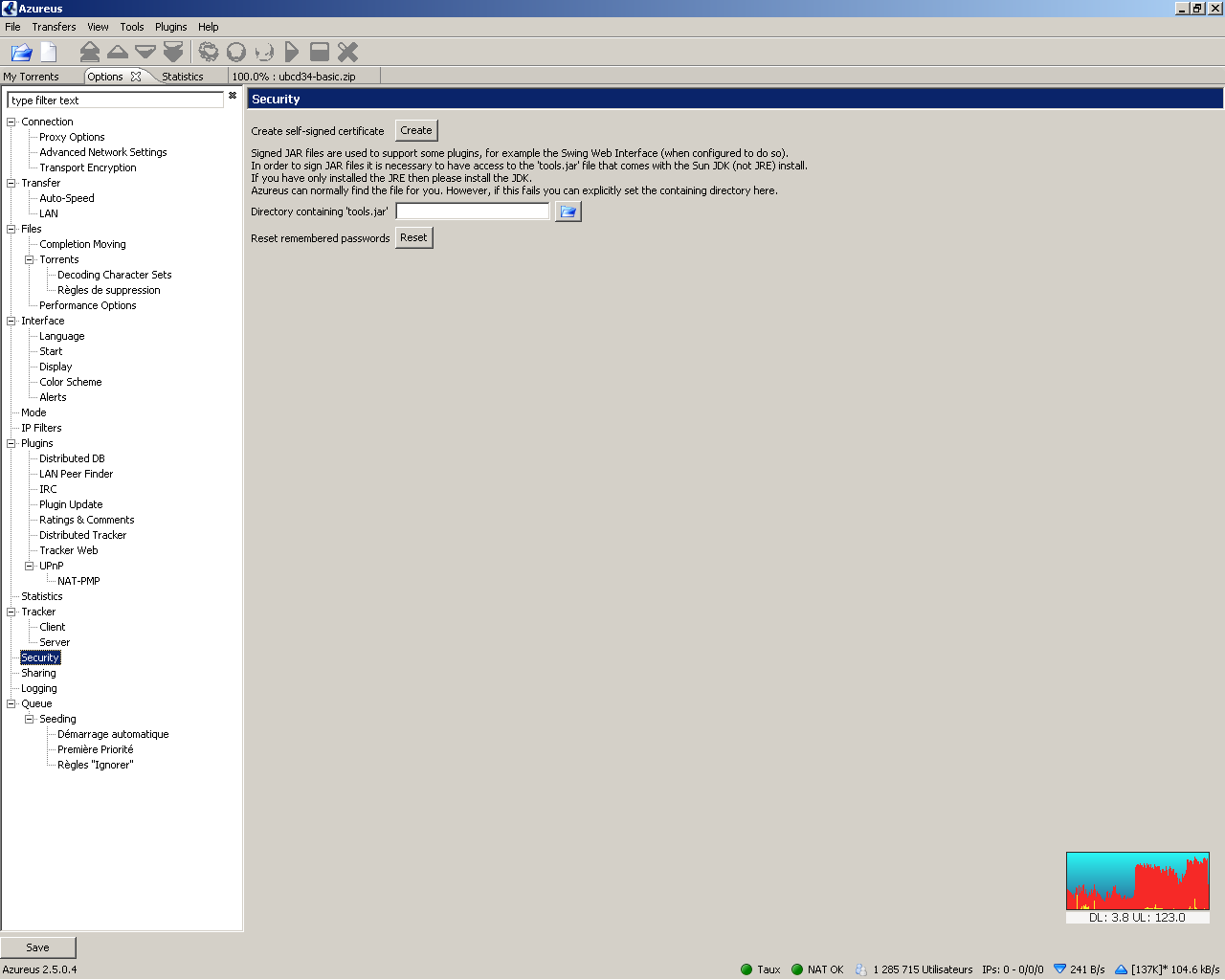
Signed certificates will probably be useful to secure the use of plugins. But I am not ready to start complicating things more than what Azureus already does by itself.
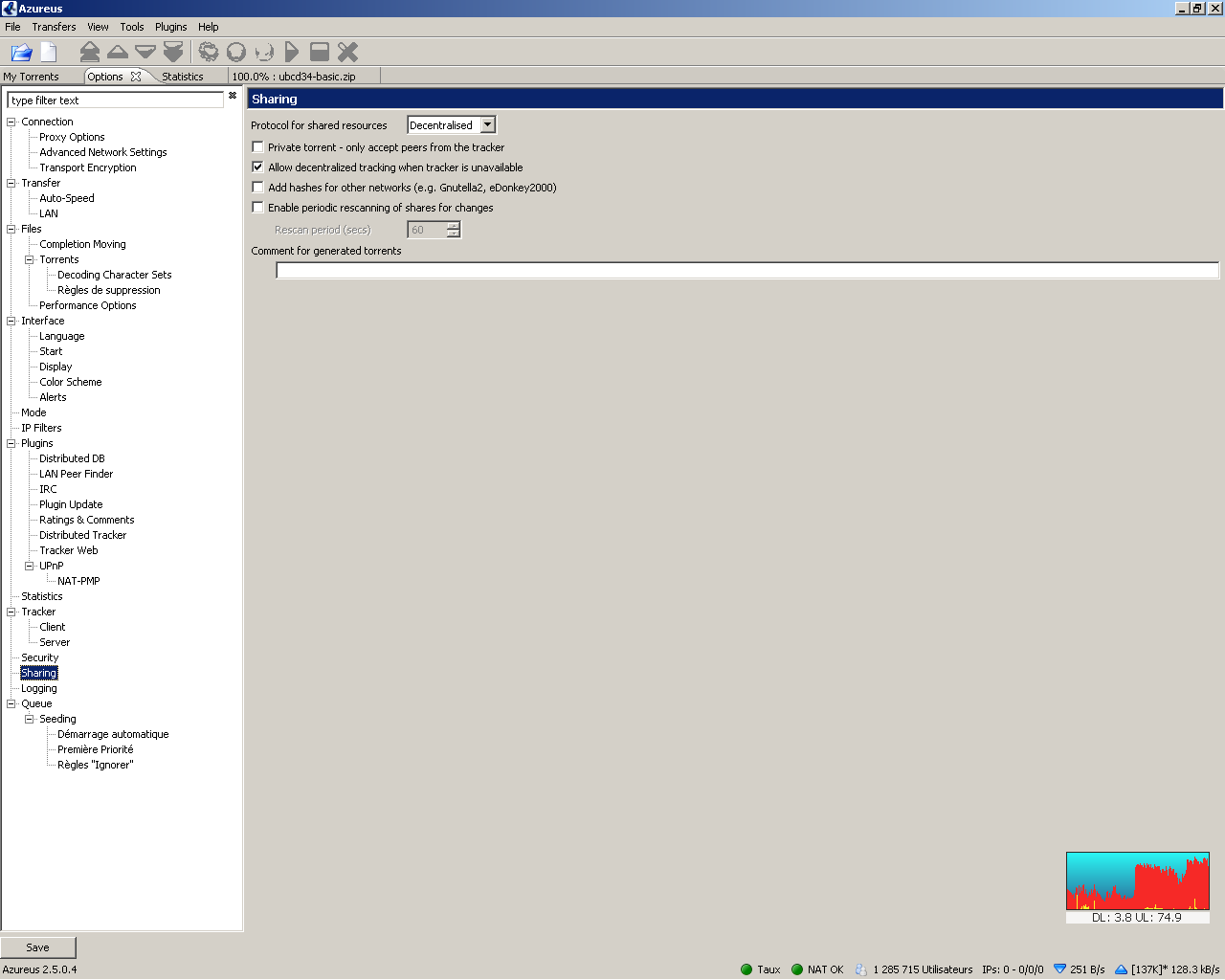
No file sharing here: Minimal configuration.
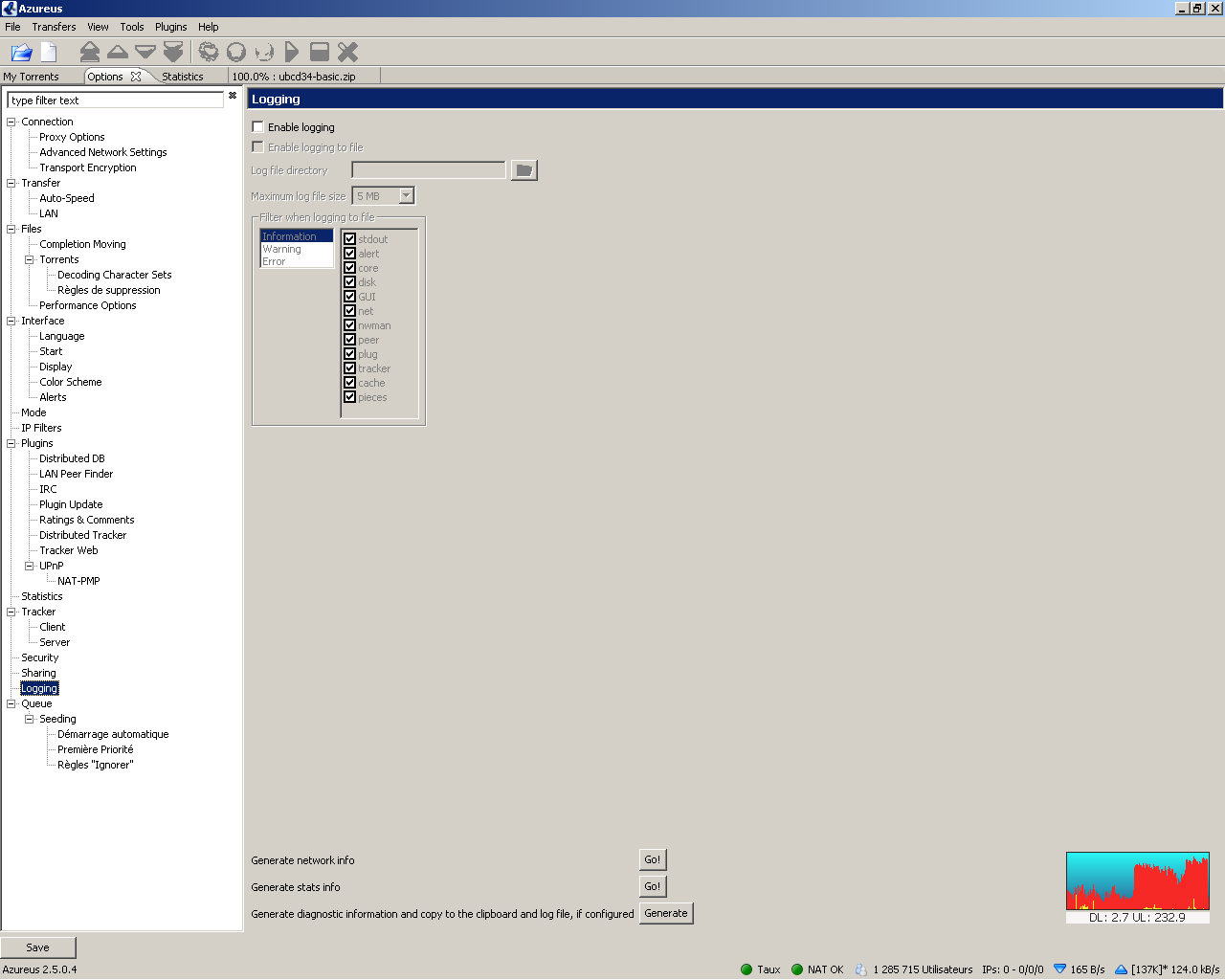
Data logging is useless in 99% of cases.
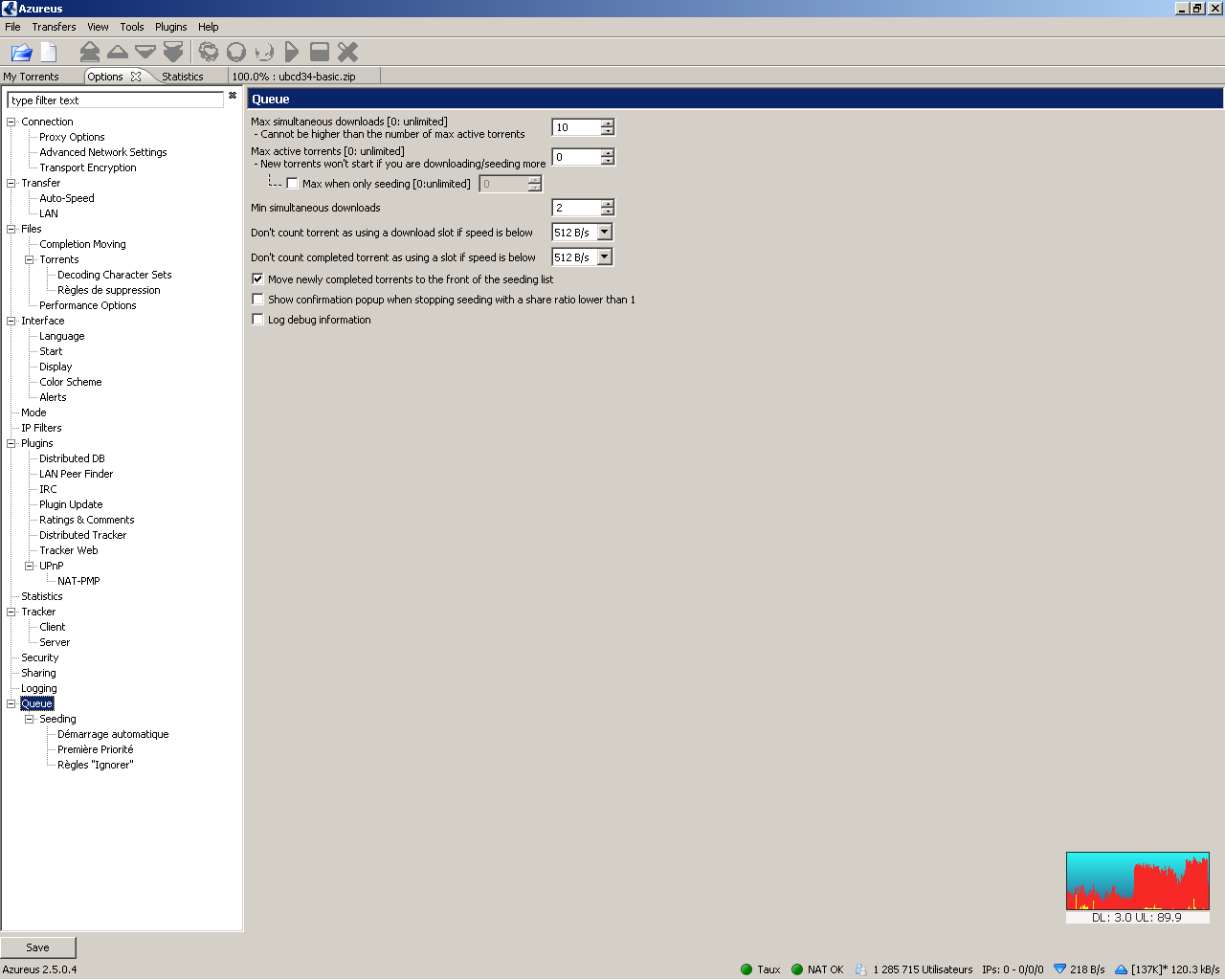
Having a good ADSL connection I did not want to reduce the number of simultaneous downloads (or not much: 10).
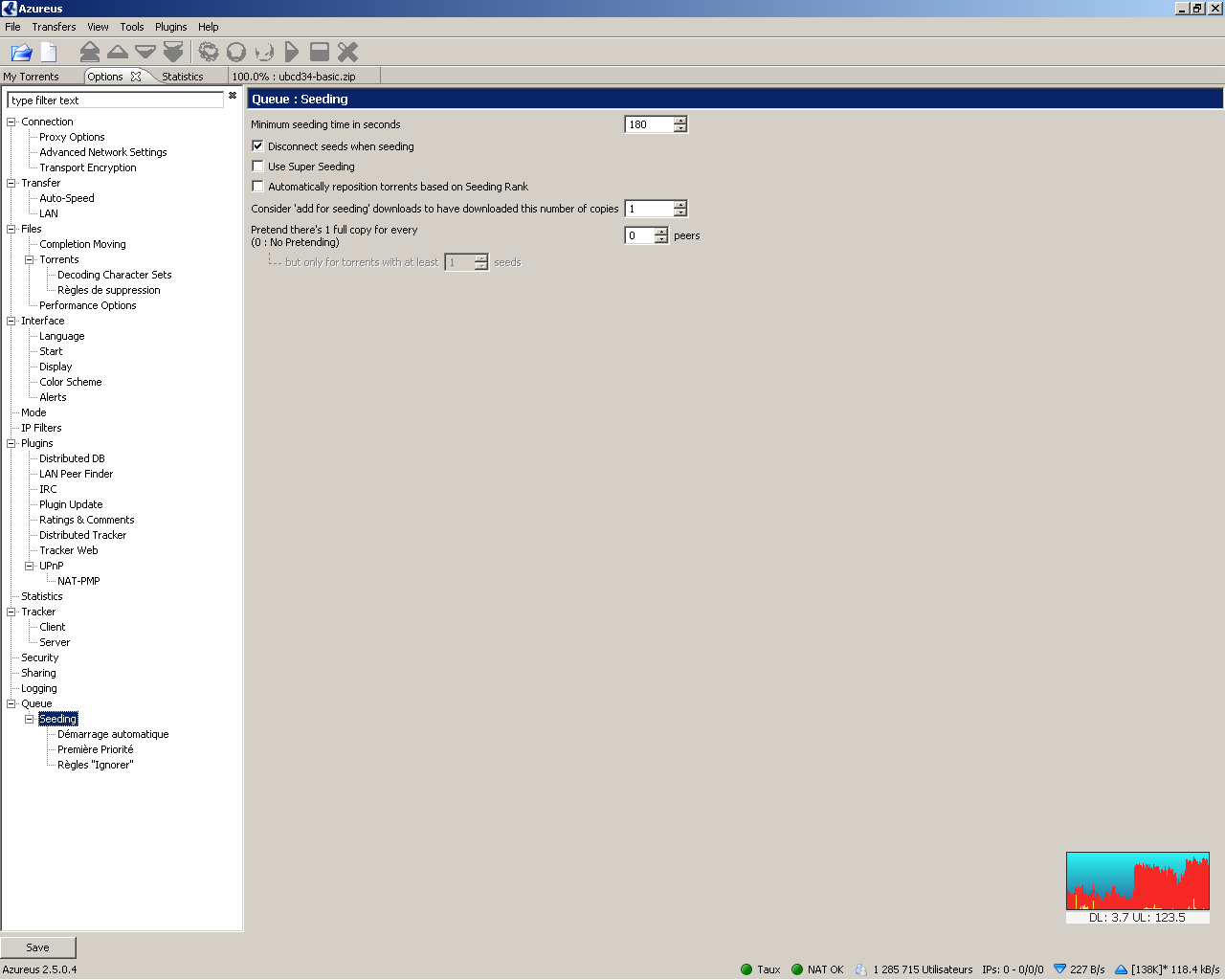
Do not use Super-Source mode if you do not intend to publish your own files. In all other cases, it tends to reduce the quality and the quantity of your downloads.
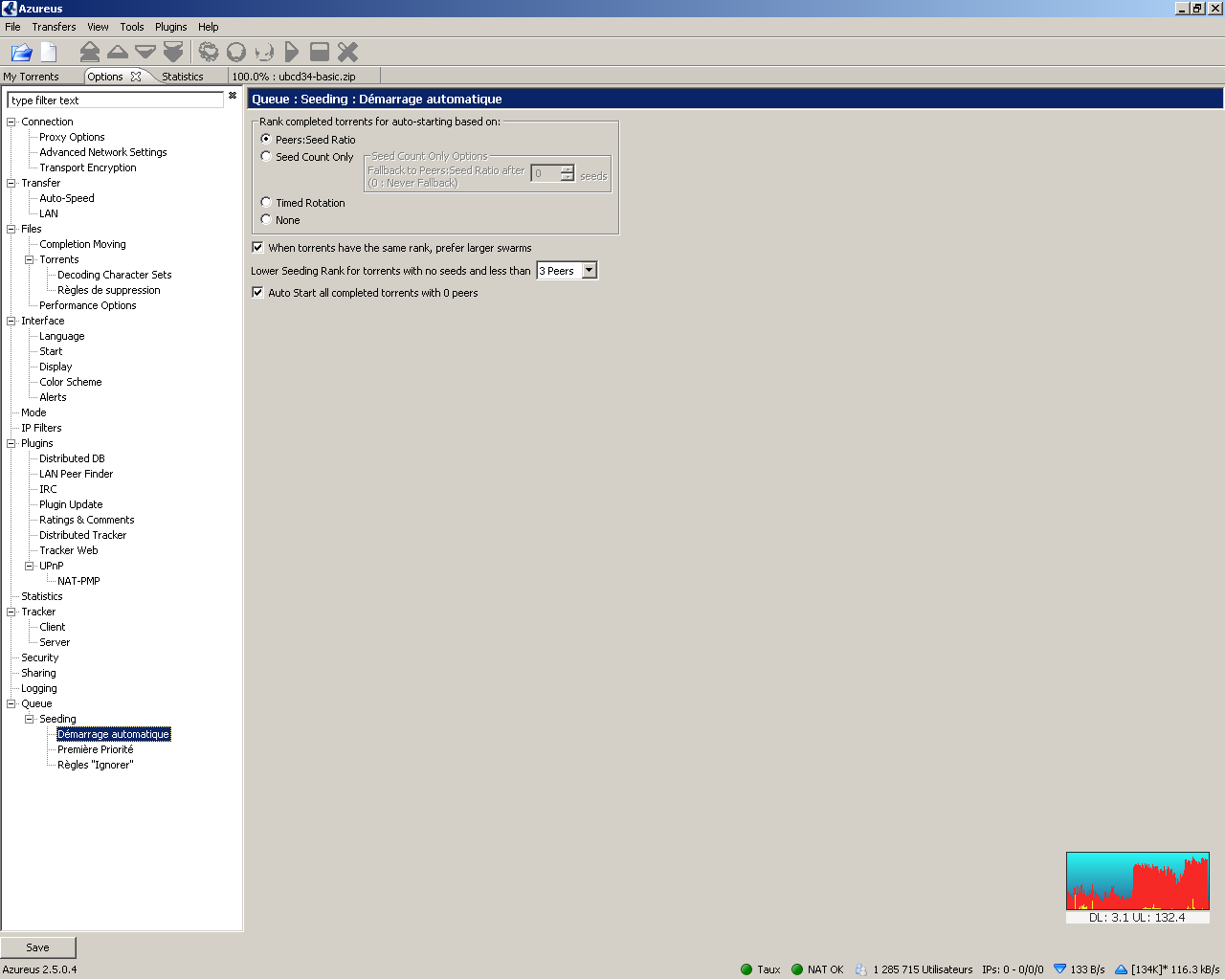
Here you find settings that should favor politeness, fairness and philanthropy while sharing: Help those torrents that are the more in need or that I did not help much up to now. Same for the next screen copy:
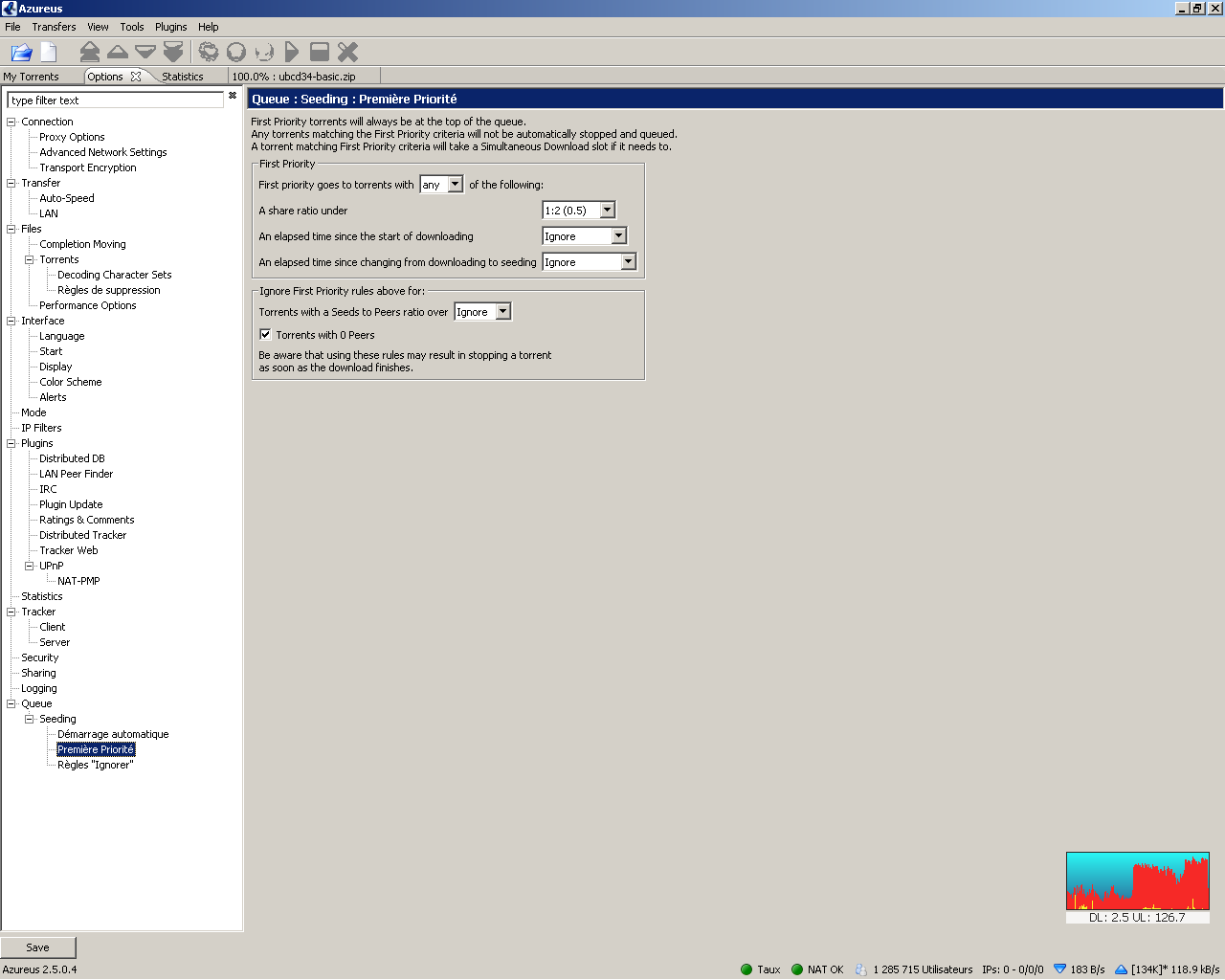
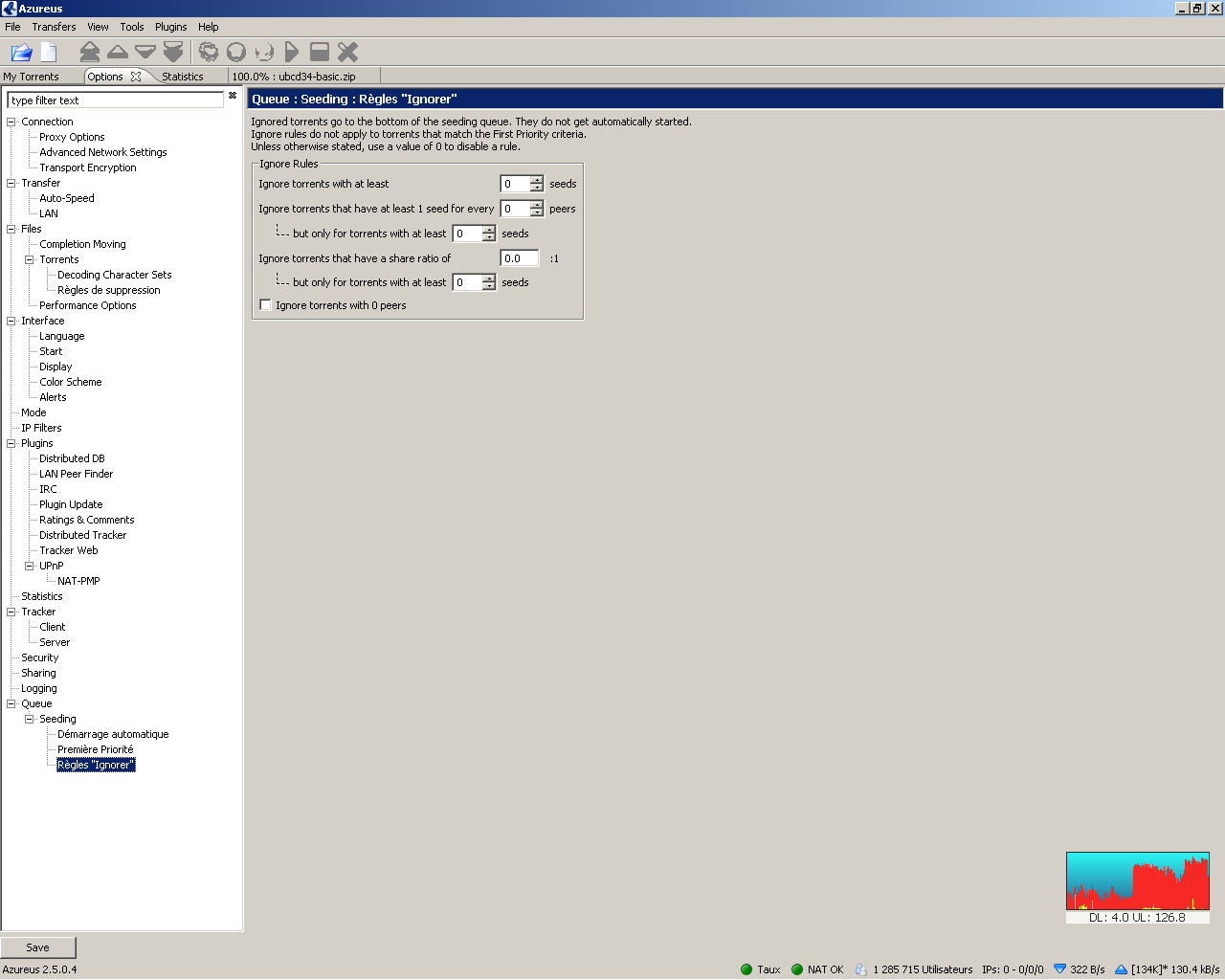
I don’t ignore torrents.
Conclusion
It is not impossible to work with Azureus. But you’d better find your way in the many options for configuration. Default options are relatively safe (happiliy, or it would be a problem for a popular success).
I would only add a remark about the coding of the application in Java. Clearly, this is what allows Azureus to work on so many platforms and so many different machines. This is also an application using a lot of memory (much more than BitComet or µTorrent). I heartily recommend 1 GB of RAM under Windows 2000 pro. I guess that 2 GB will be needed under Vista (knowing that Microsoft already advise to use 1 GB RAM for the OS only).
The Azureus version used here is: v2.5.0.4.
Additional note: For those wondering what is the little red graph appearing at the bottom right of all screen copies, this is BitMeter2 a traffic metering applet for Windows that I use permanently on my PC. I actually forgot that it would be appearing on all the screen copies. Those interested in the little detail will notice that I started a big file transfer (the sudden increase in the red zone) a few minutes before I started to capture the screen copies.
Leave a Reply